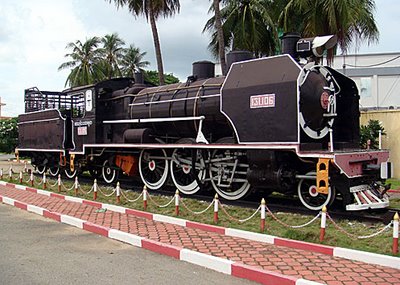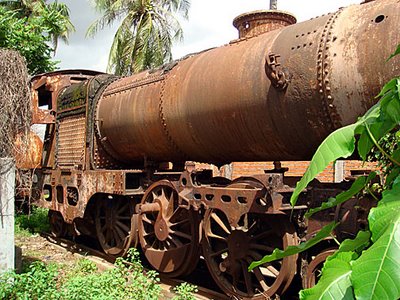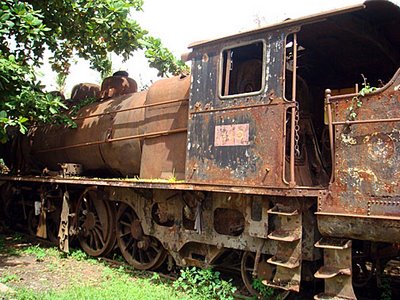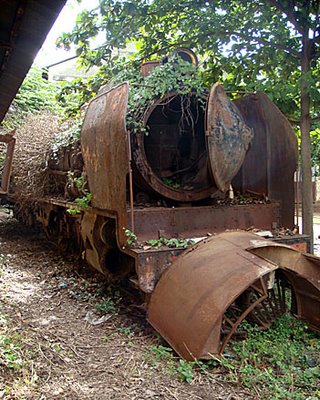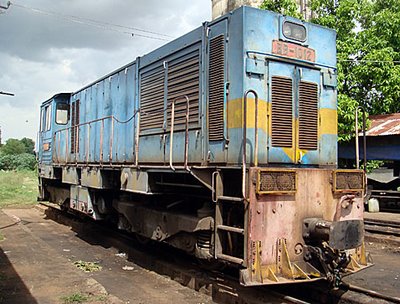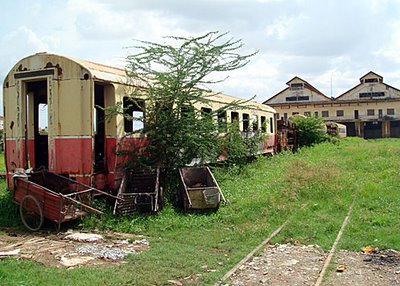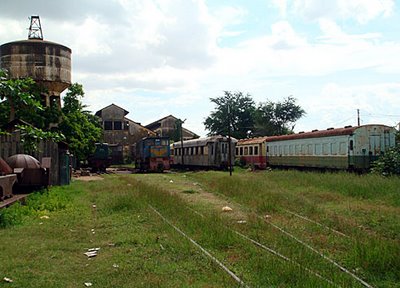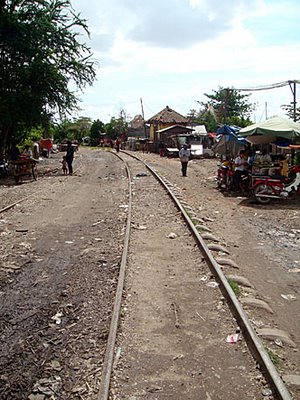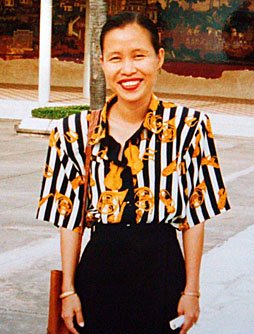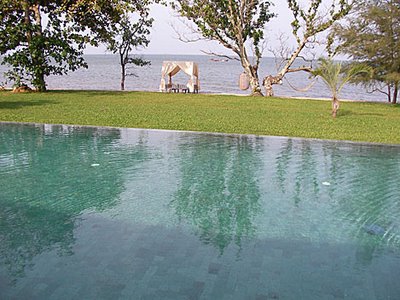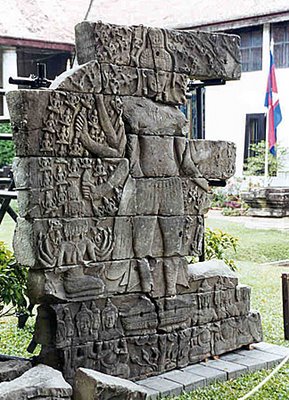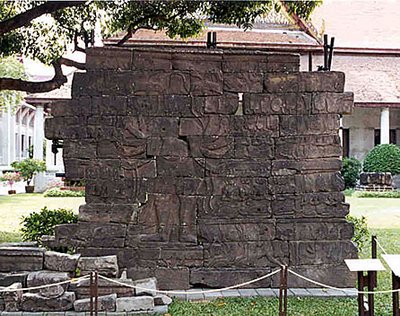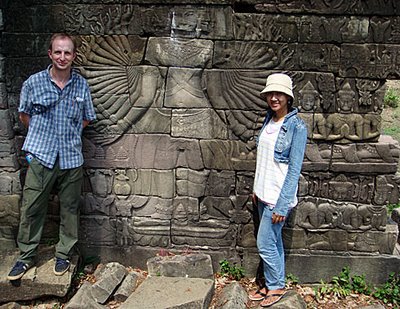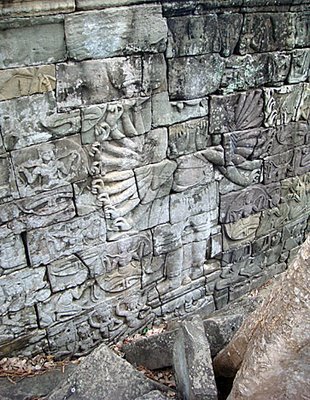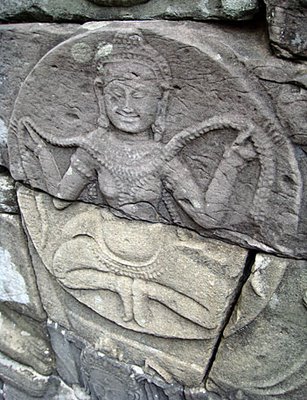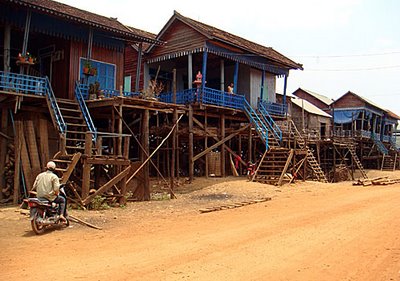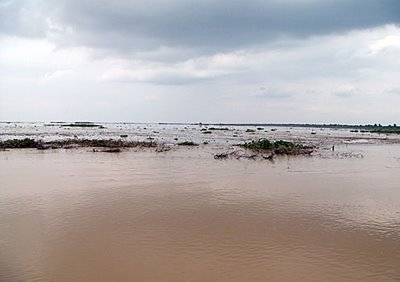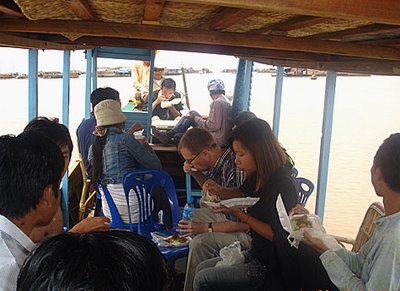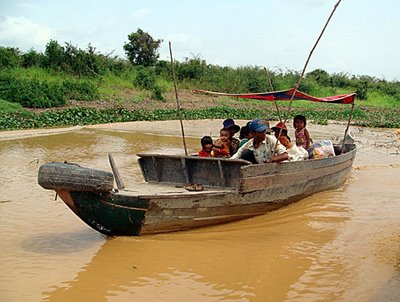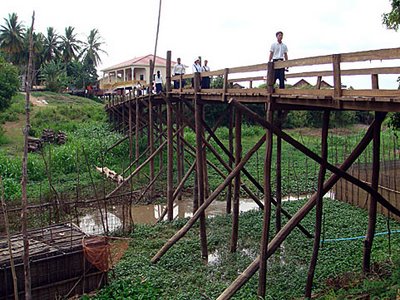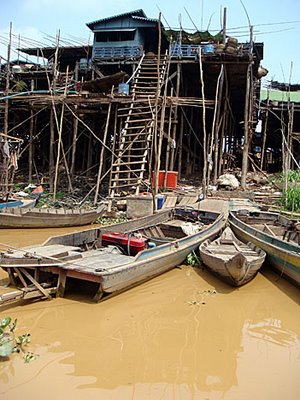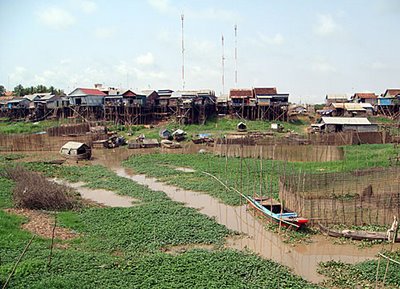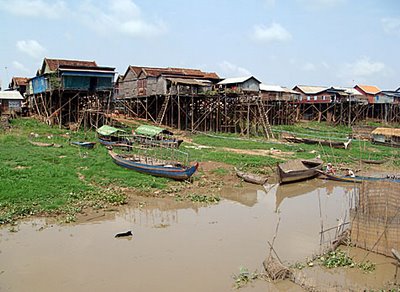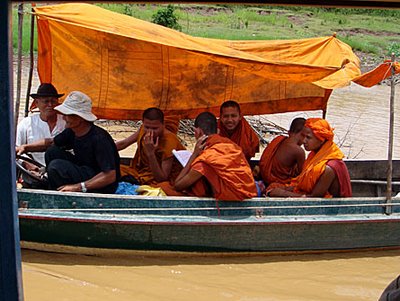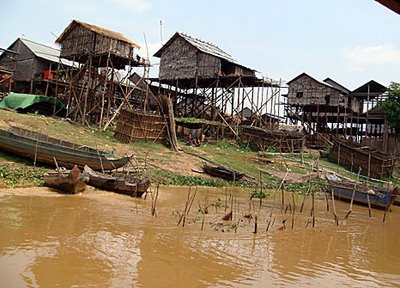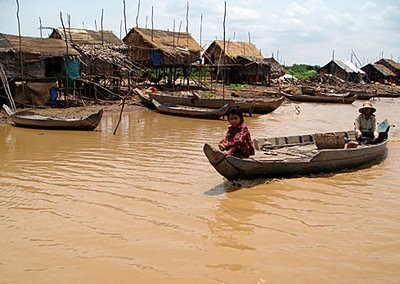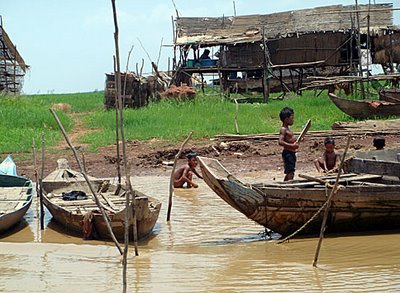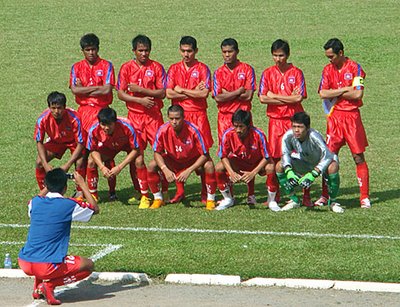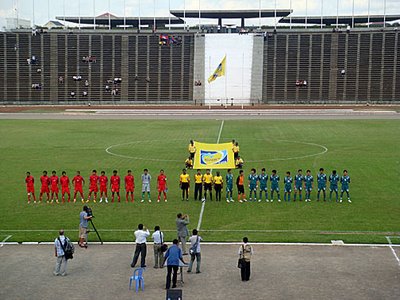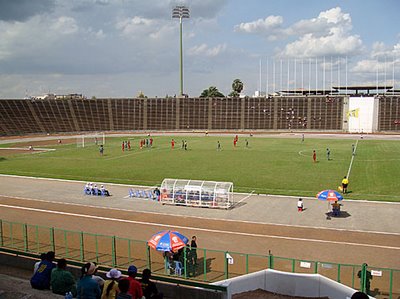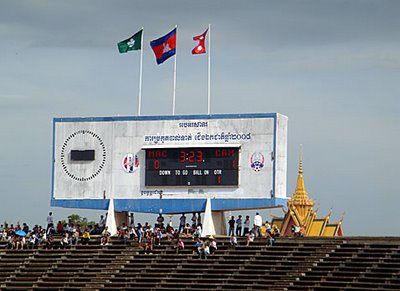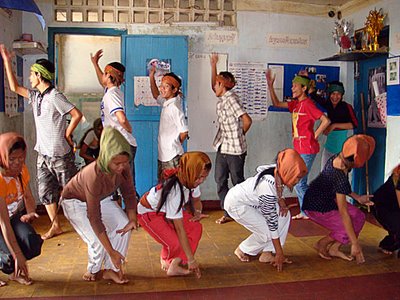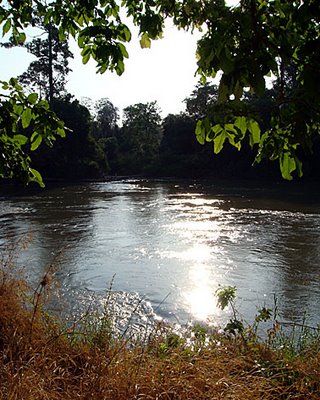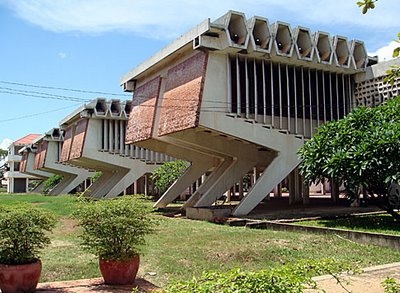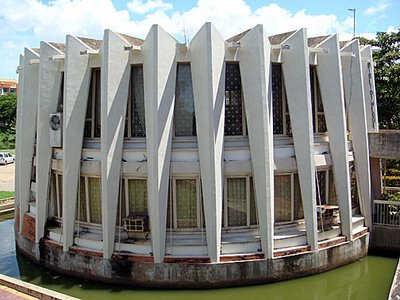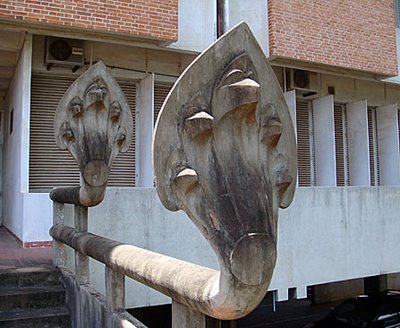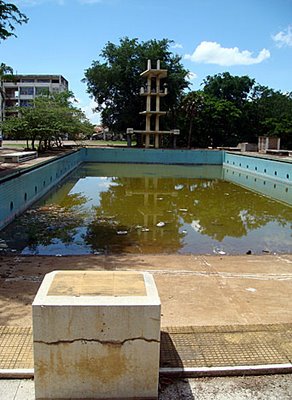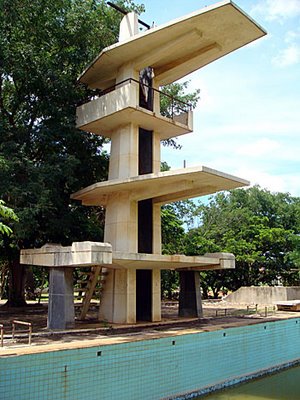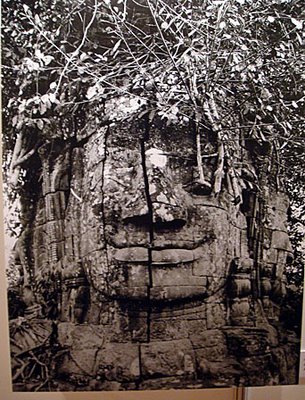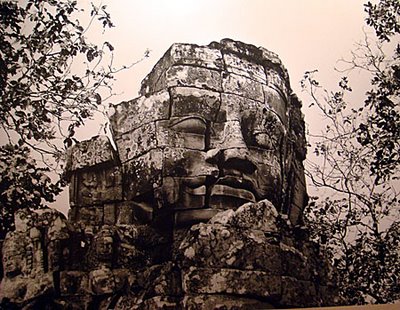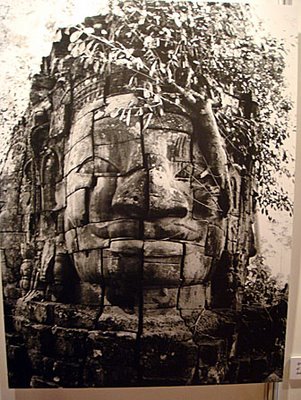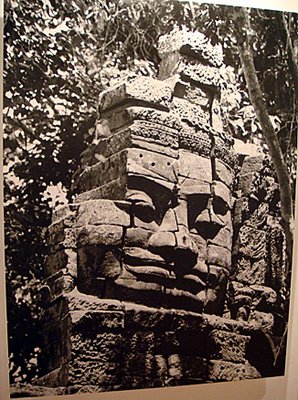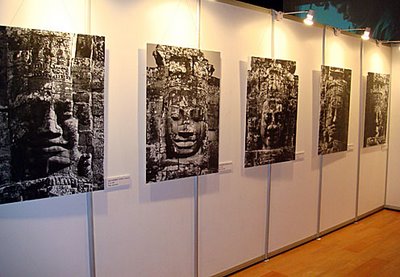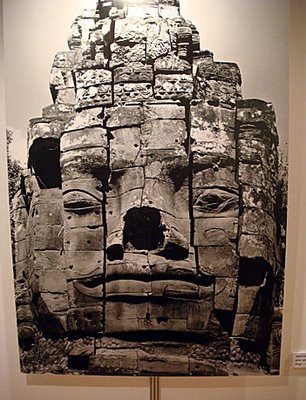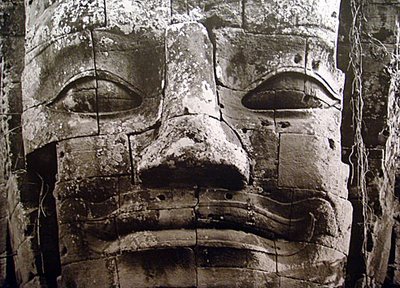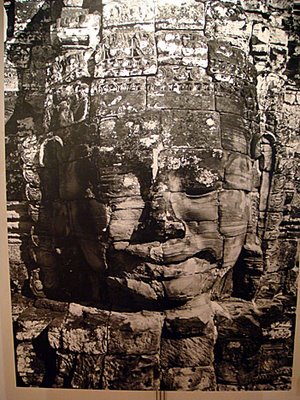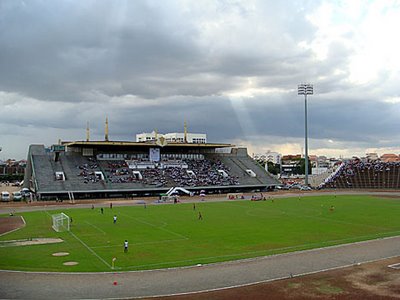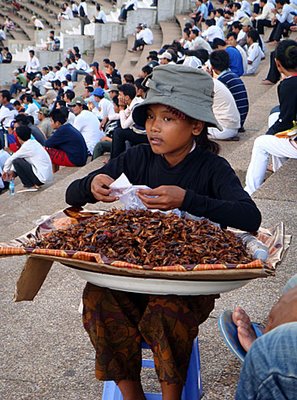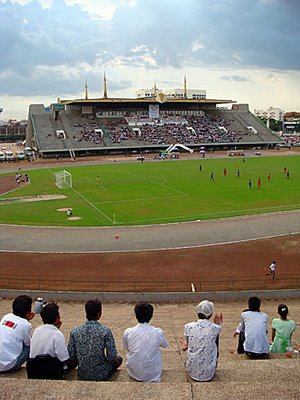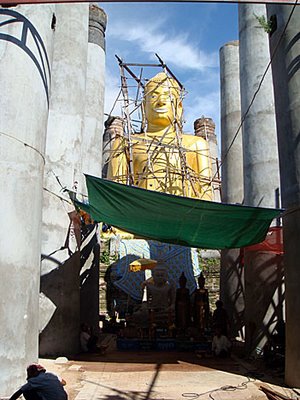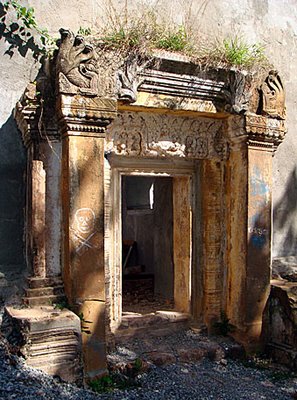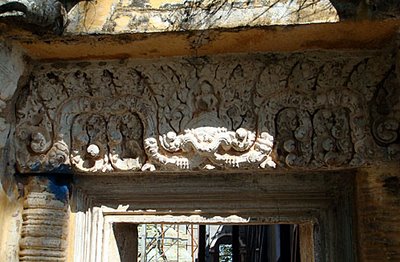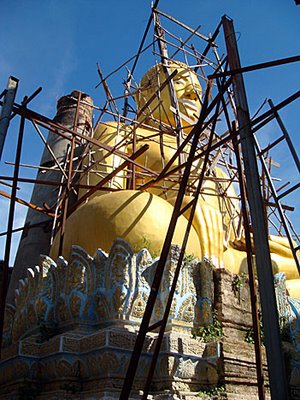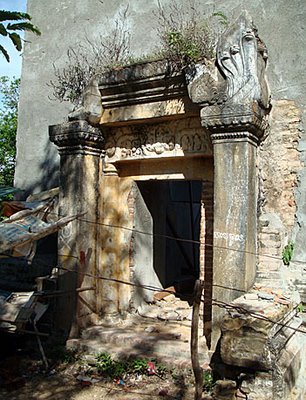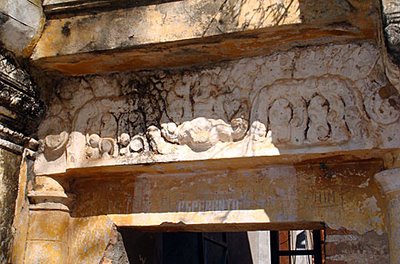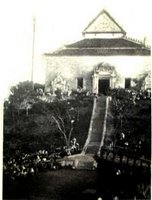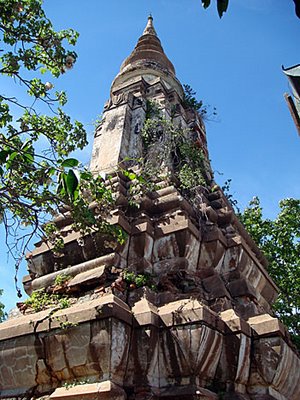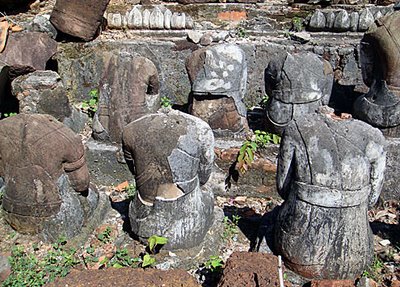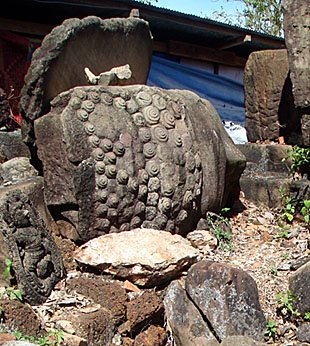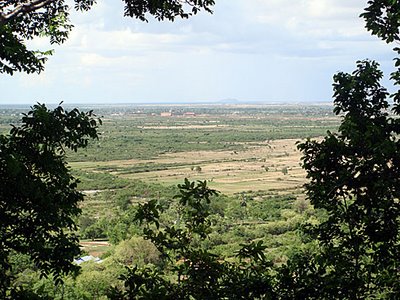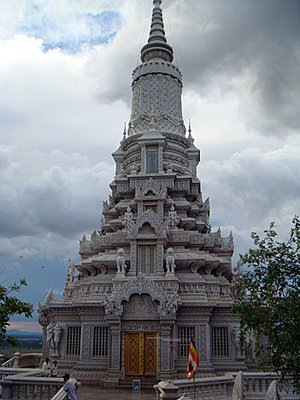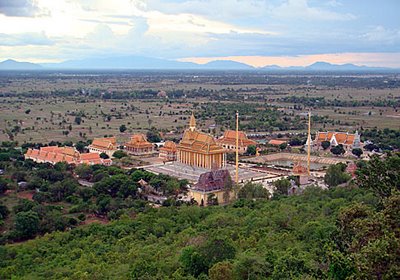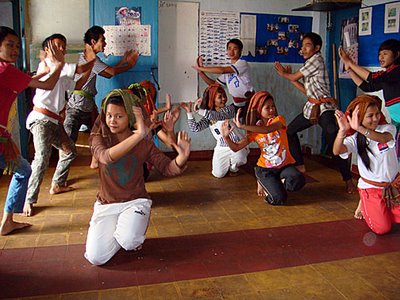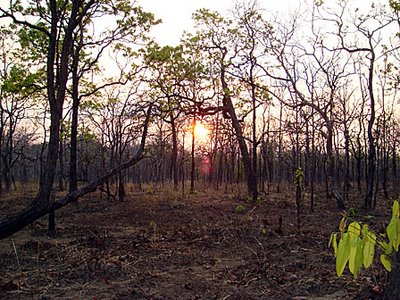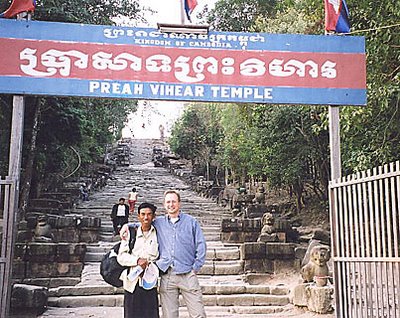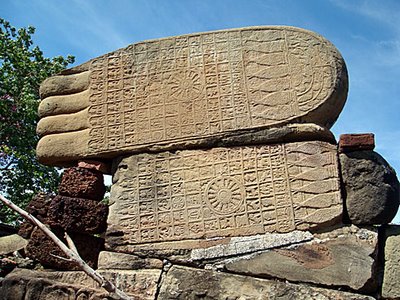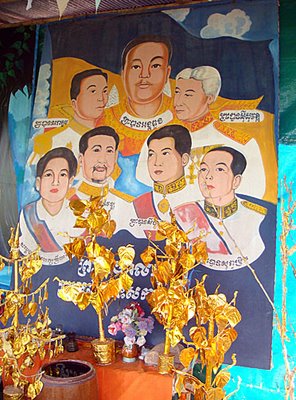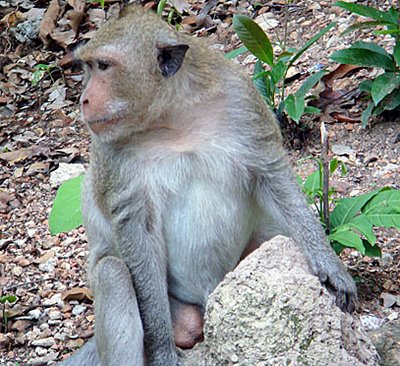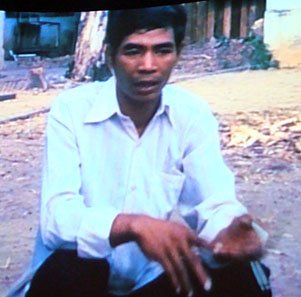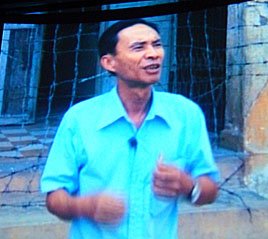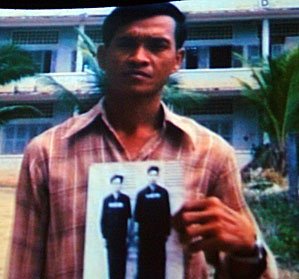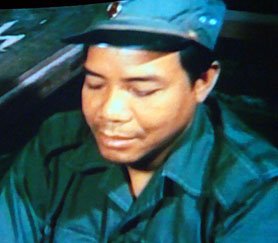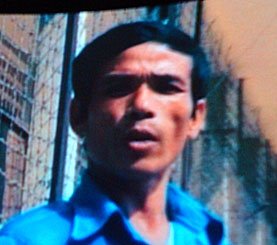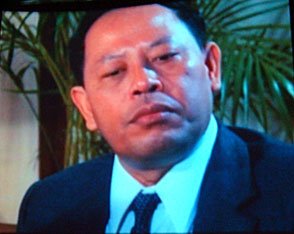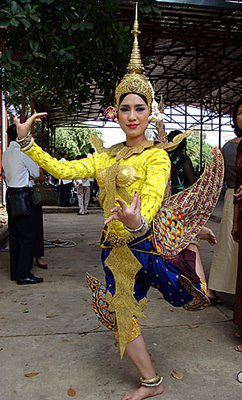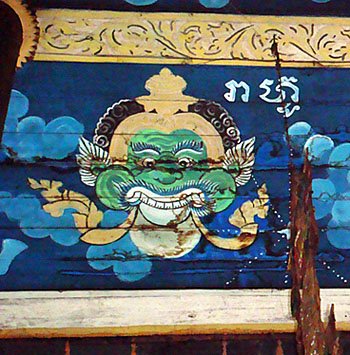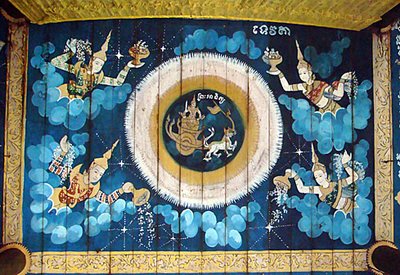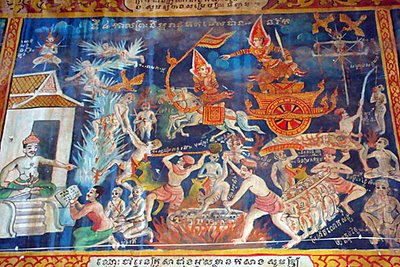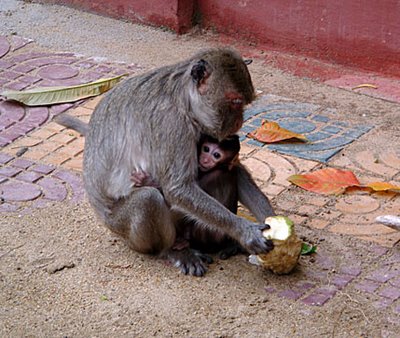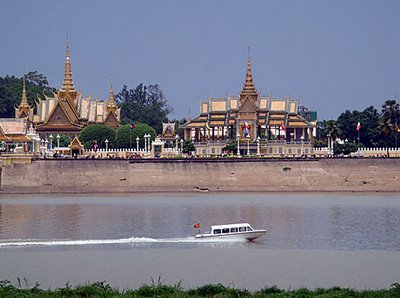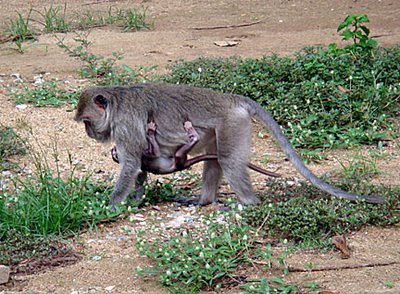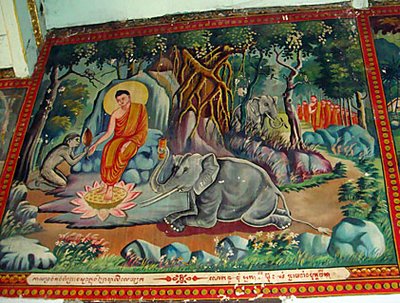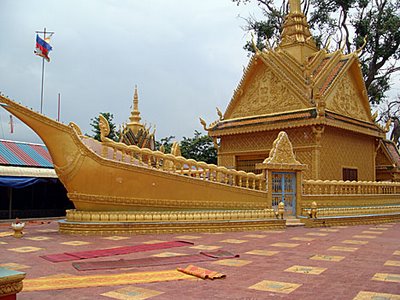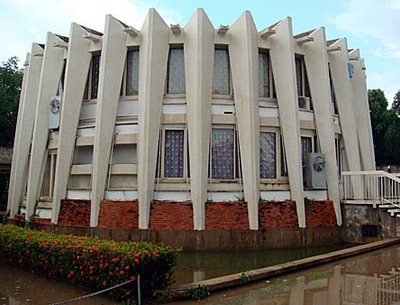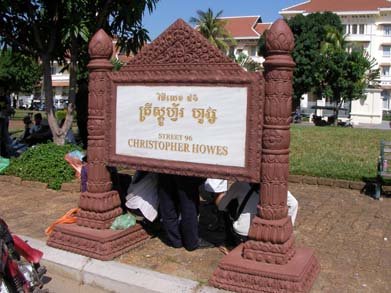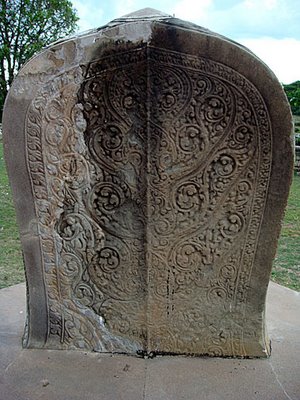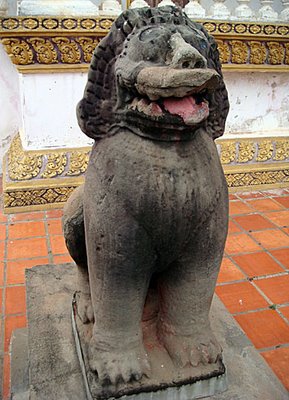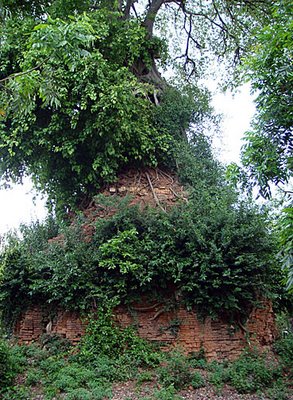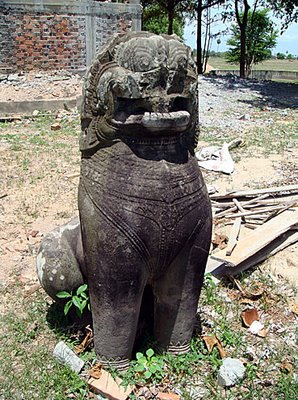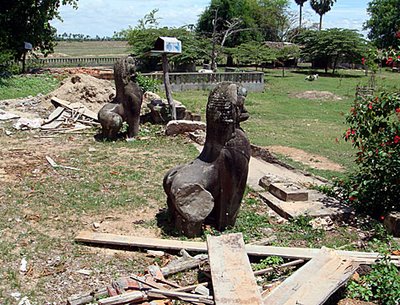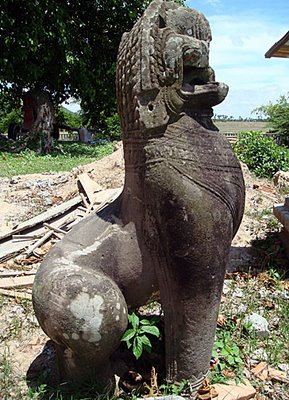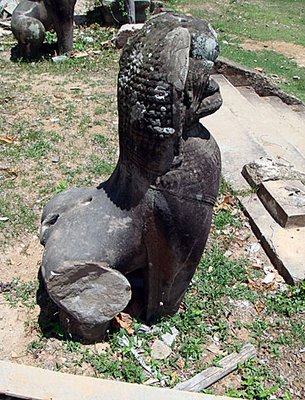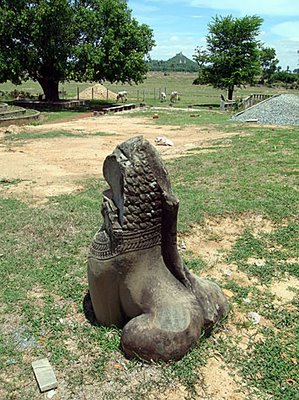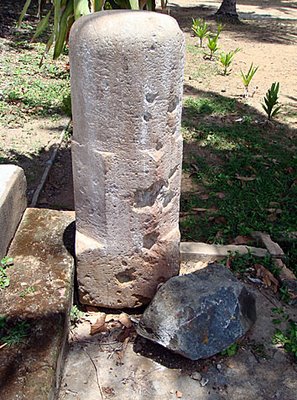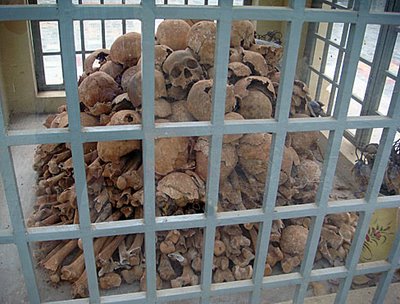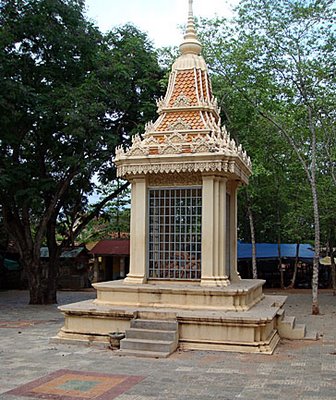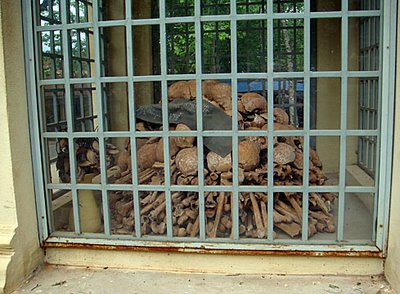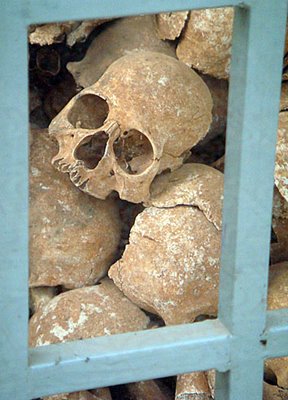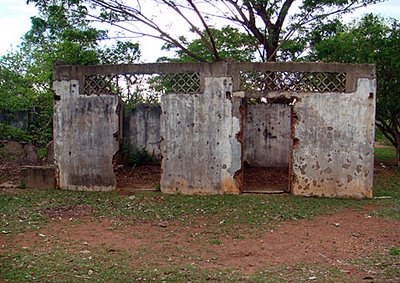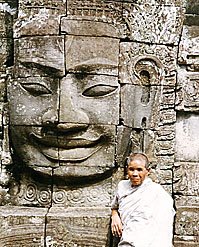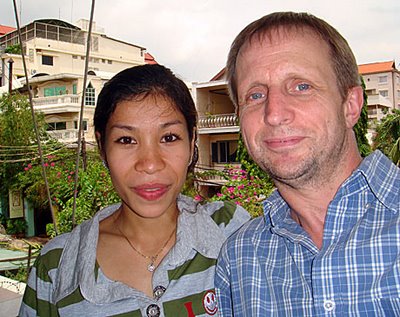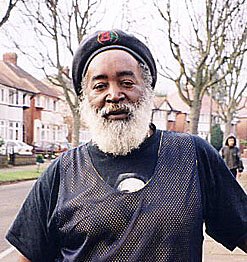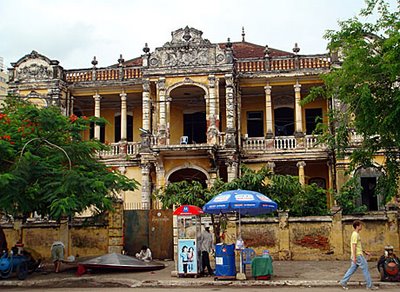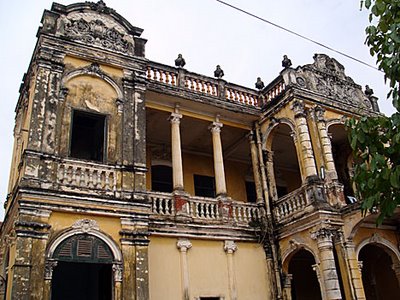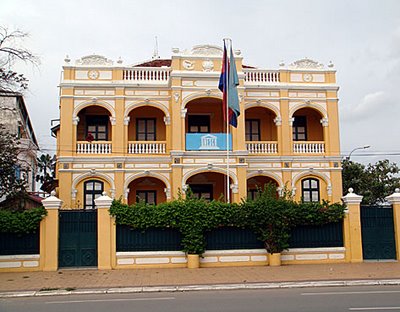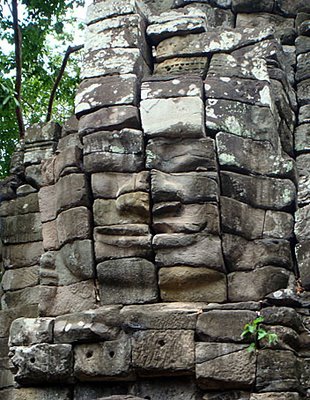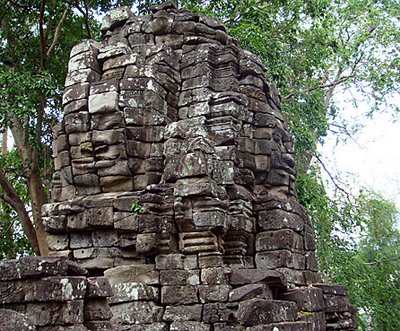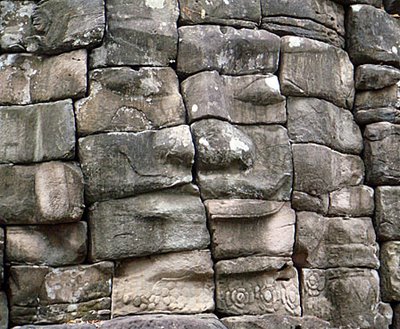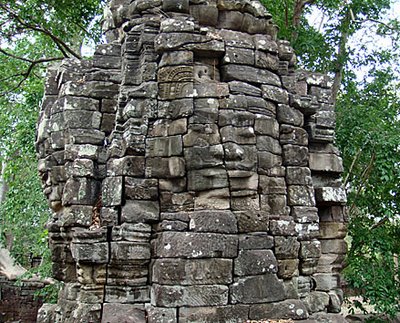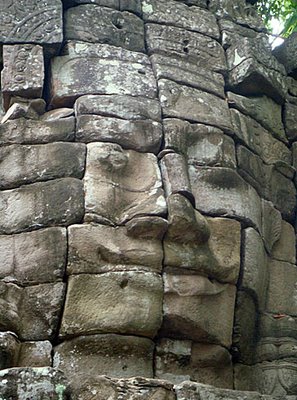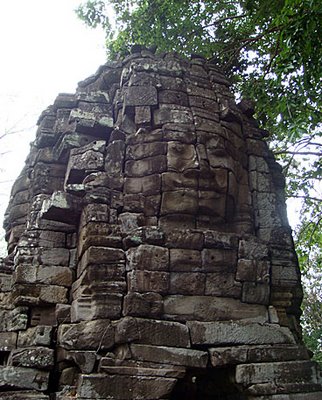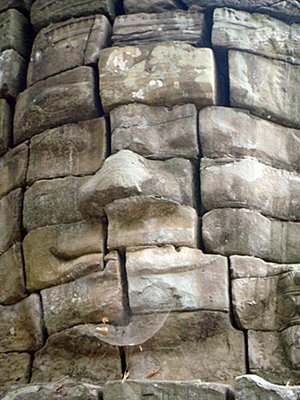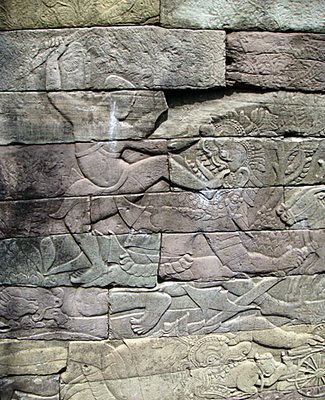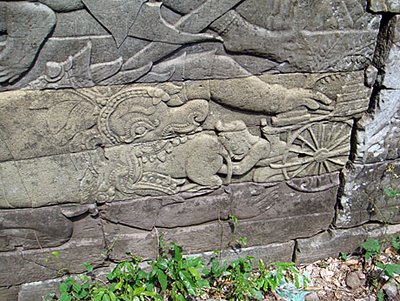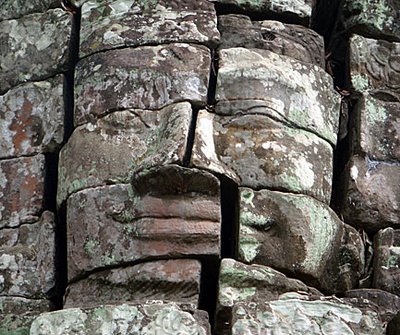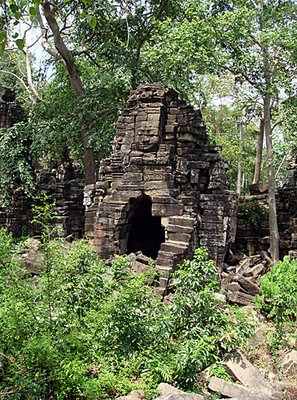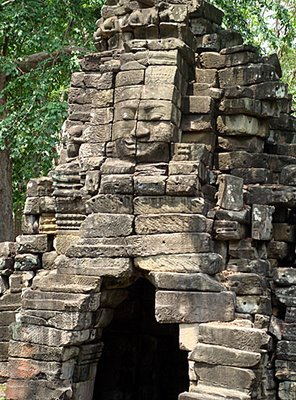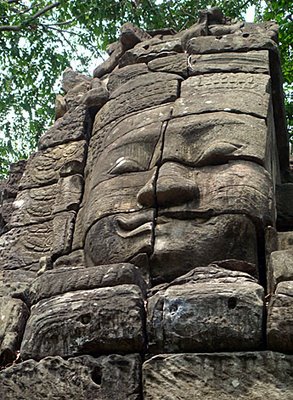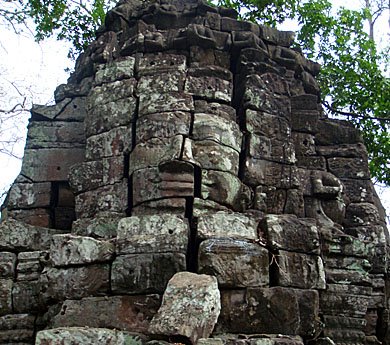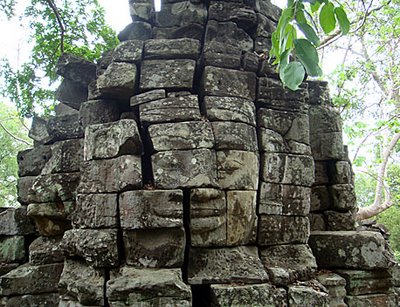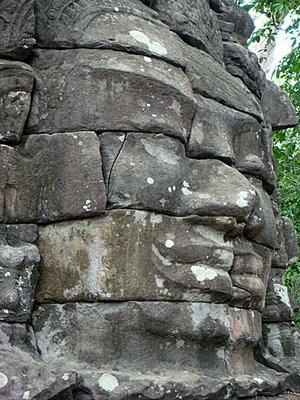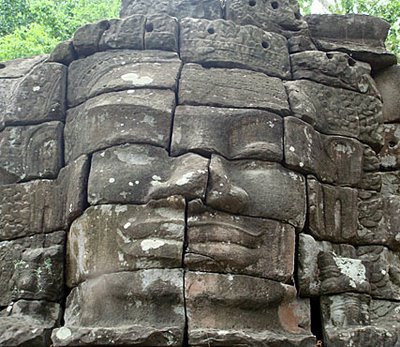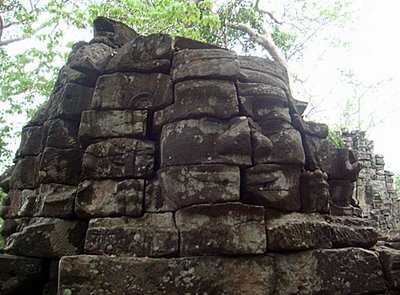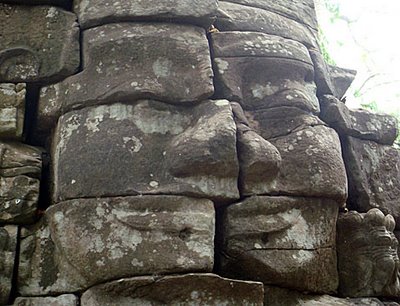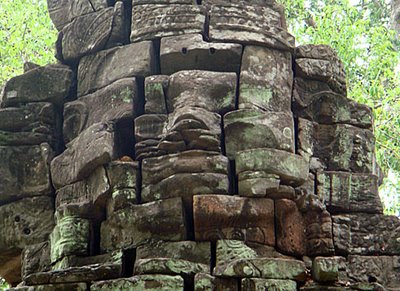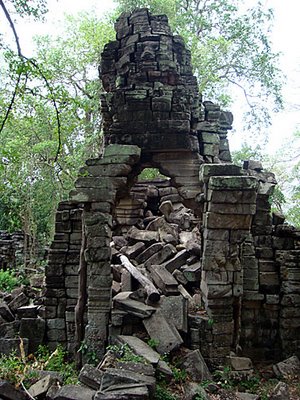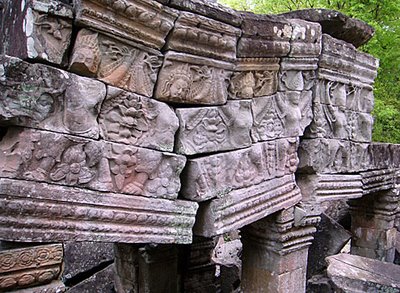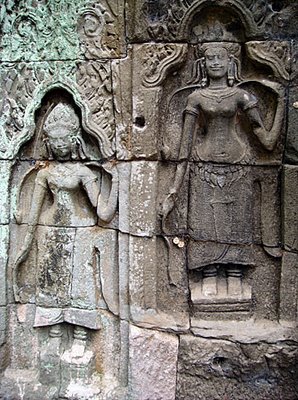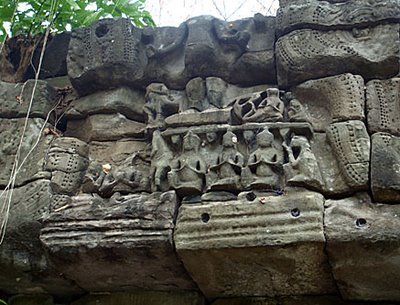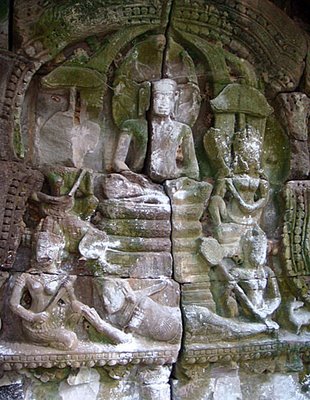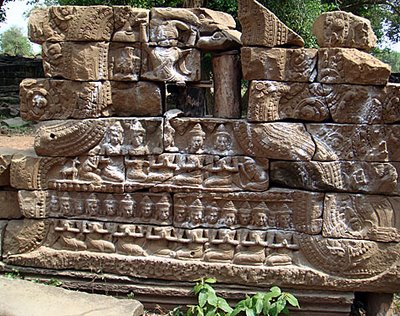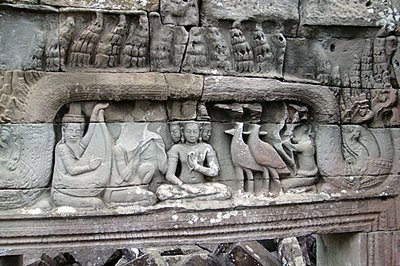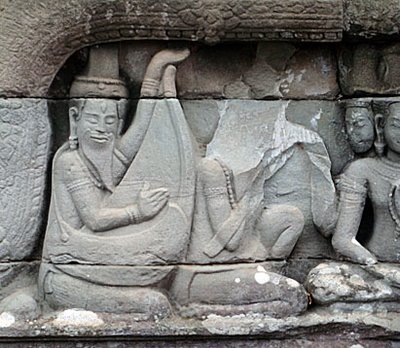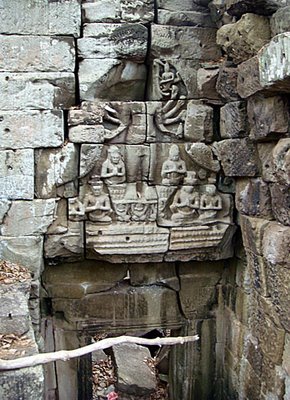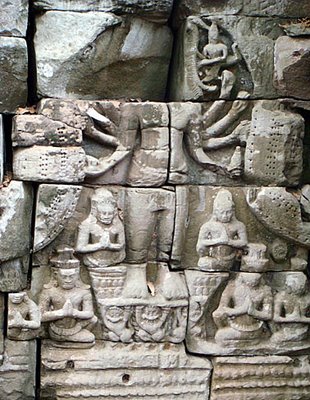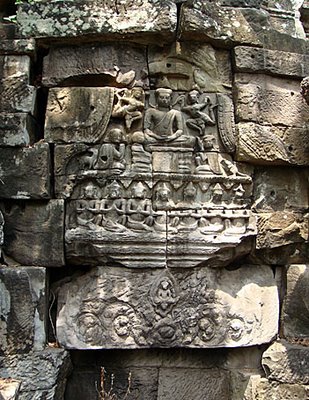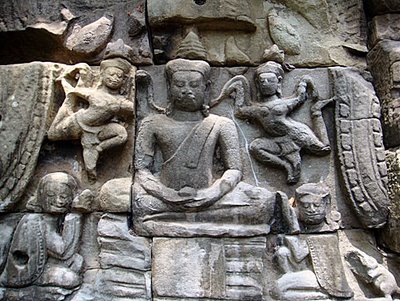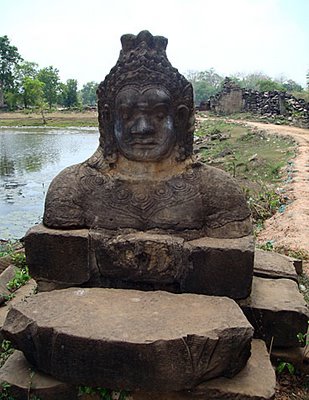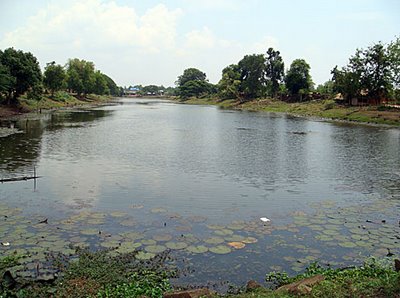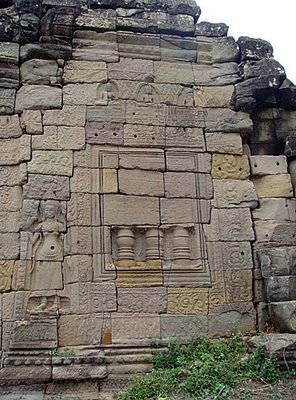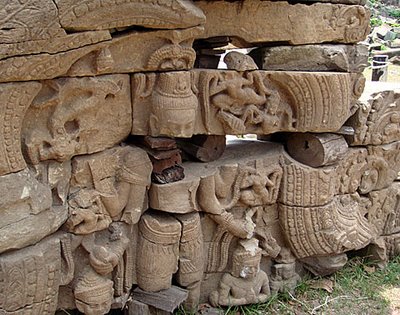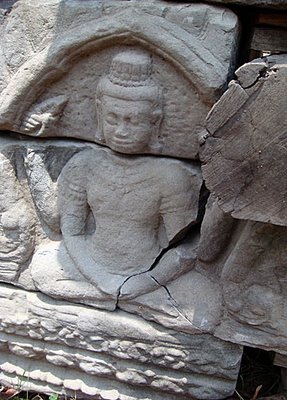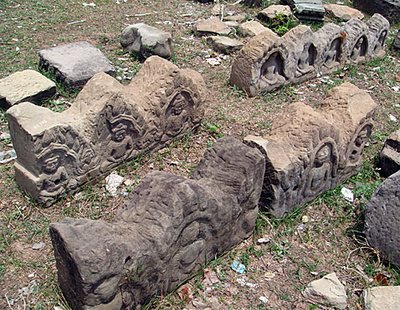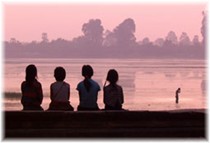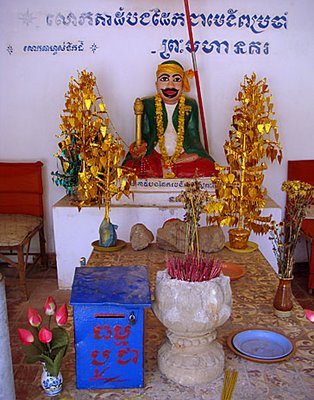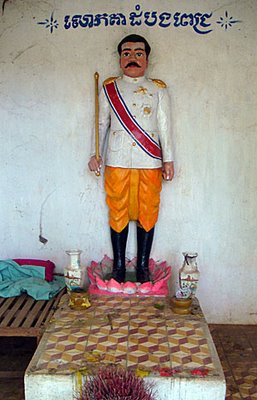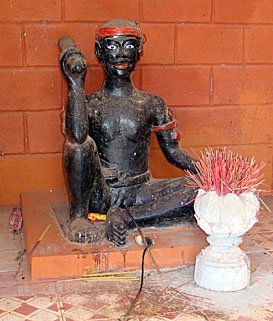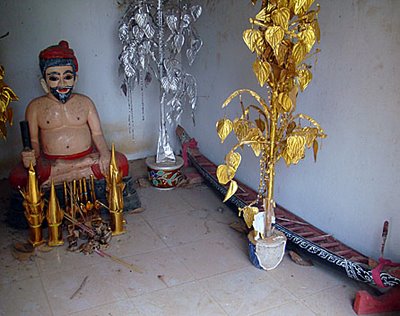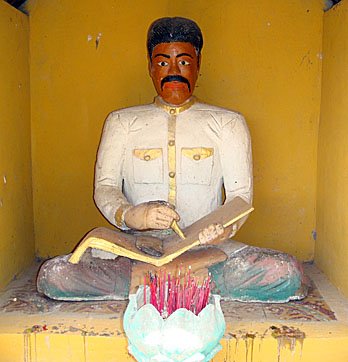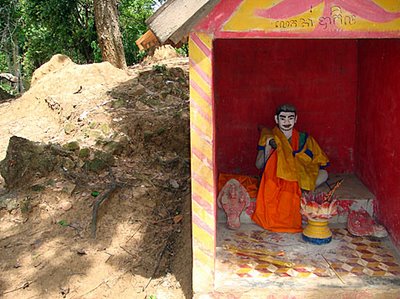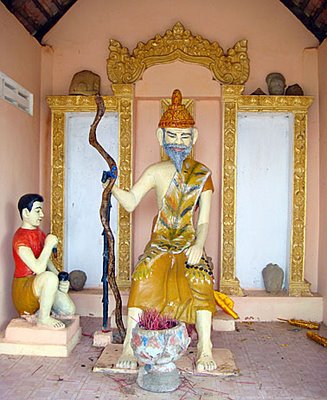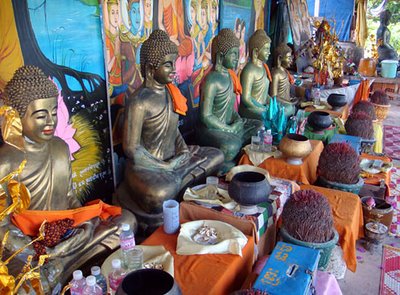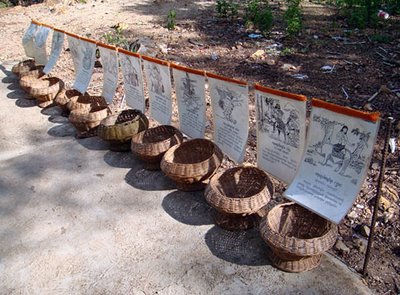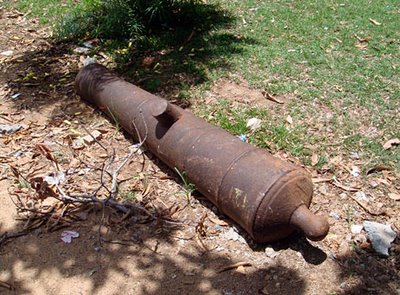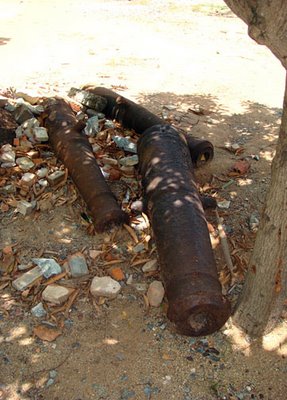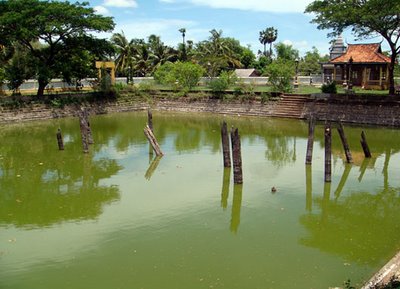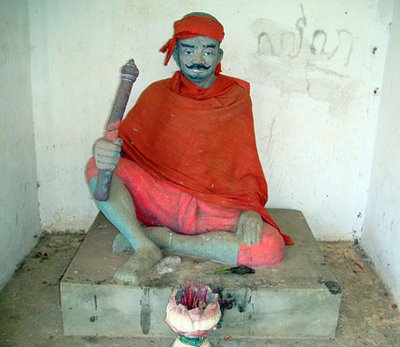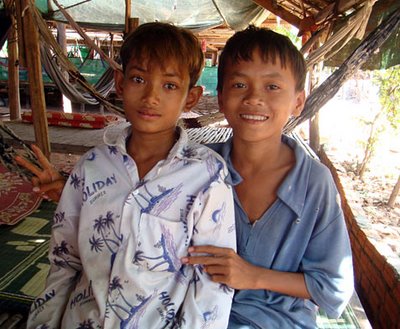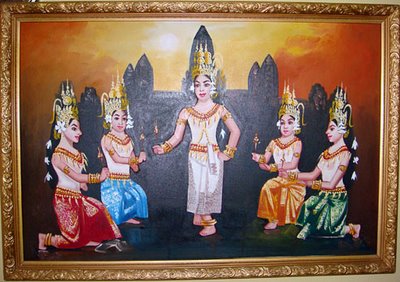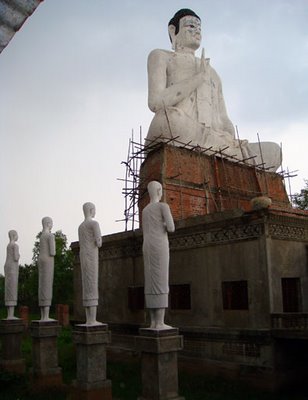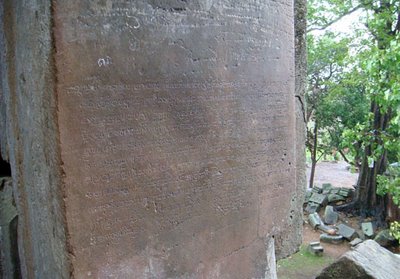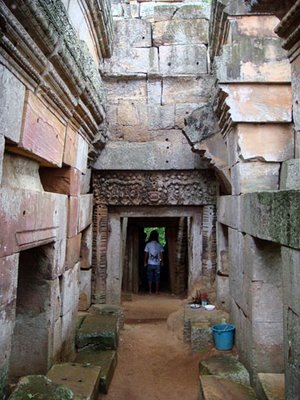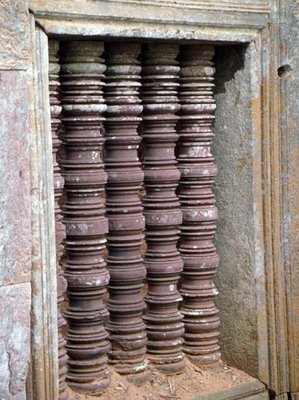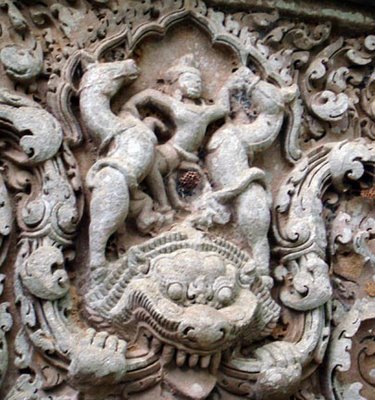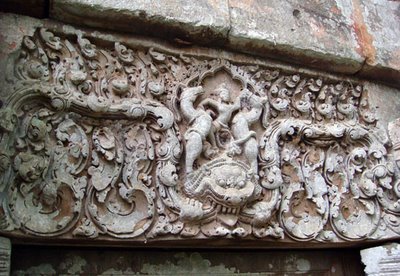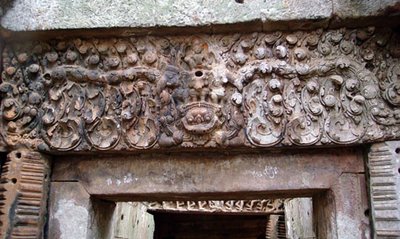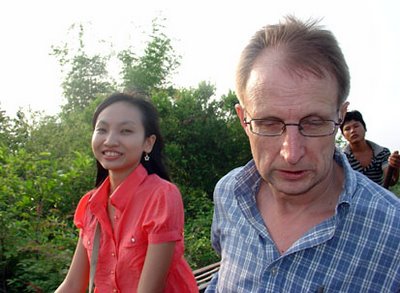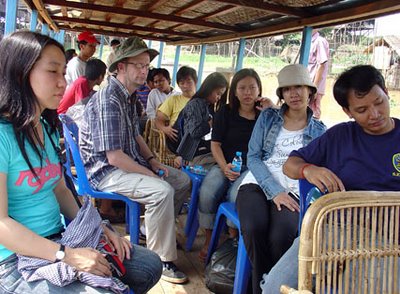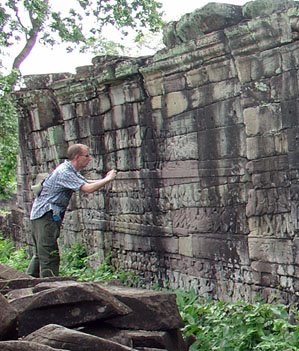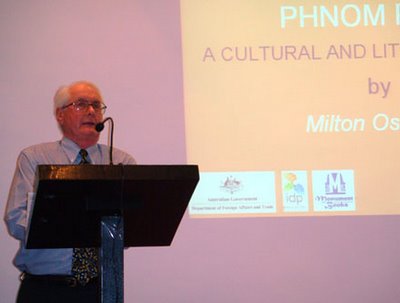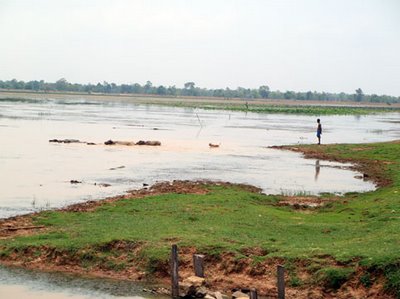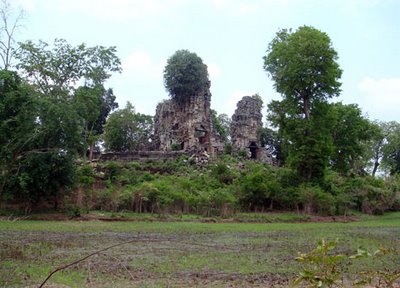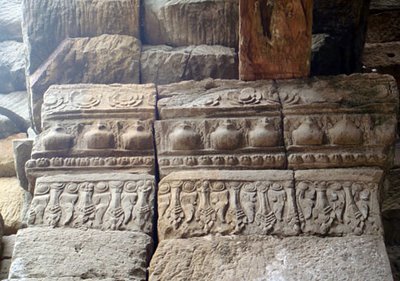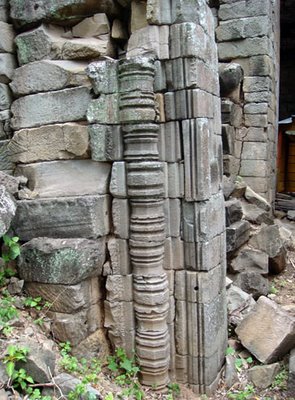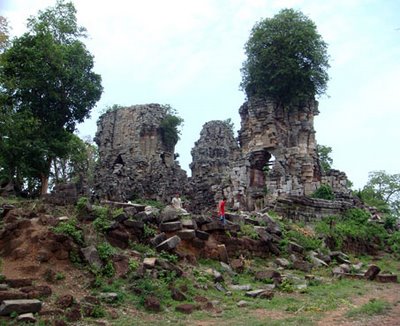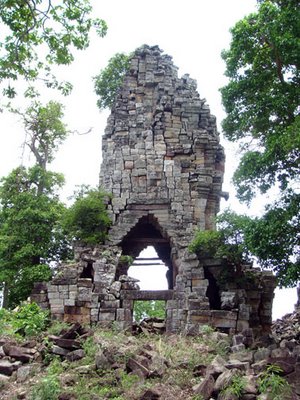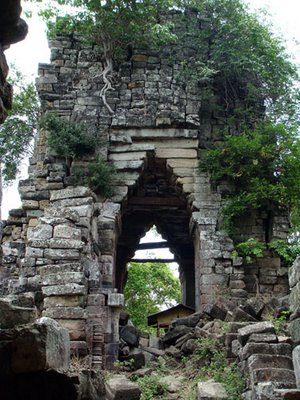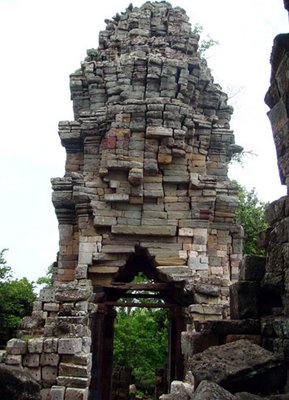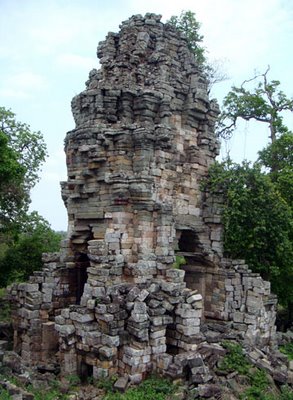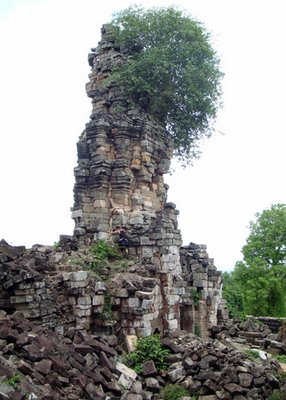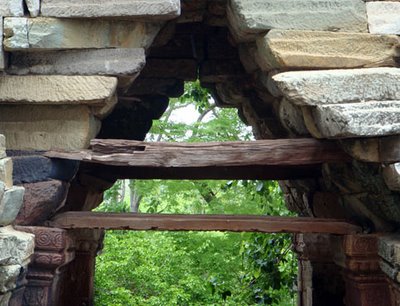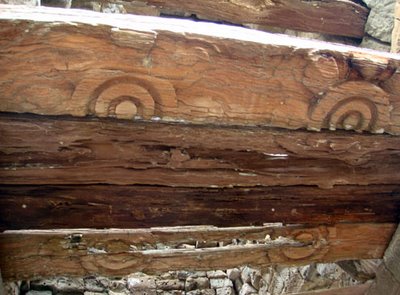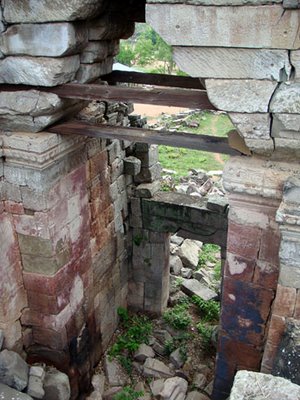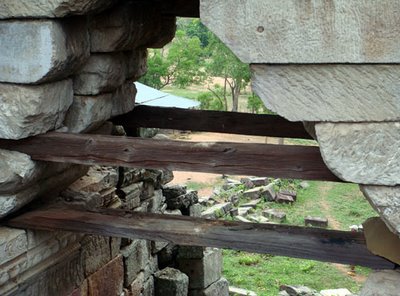Saturday, May 31, 2008
Friday, May 30, 2008
Looking back to 1994
Cambodia : A Land of Charm & Cruelty
The name of Cambodia is synonymous with the cries of the tortured and starving and more recently, the murder of western tourists by the genocidal Khmer Rouge, responsible for the deaths of over one million of their fellow countrymen in the late 1970s. However, that was my choice of destination for a week's break from the rigours of C&G life at Chief Office in late October [1994]. Cambodia, racked by civil war for the last twenty-five years, is one of the world's poorest countries with a population of nine million, the majority of whom live in abject poverty by western standards. Conversely, it is also a beautiful country with a fascinating culture and people and a history brought vividly to life by one of the world's greatest architectural achievements, the temple ruins of Angkor.
The country had captivated my attention since I was drawn to the suffering of its people in John Pilger's 1979 documentary, Year Zero. My interest was sustained as a member of parliamentary lobbying groups whose aim was to bring to an end the isolation they'd endured at the hands of the international community. A fragile peace had been achieved following the 1993 UN-supervised elections that had ushered in the country's first democratically-elected government and for the first time in recent history, the country had opened its borders to the more adventurous tourist.
Undoubtedly, the highlight of my trip was the three days I spent exploring the dramatic ruined cities of Angkor Wat and Angkor Thom. Flying from Phnom Penh, the capital, to the northern provincial centre of Siem Reap, I was unprepared for the awesome array of massive stone temples, wide majestic causeways, imposing towers and gates and beautifully intricate stone carvings that I encountered. The monuments were originally constructed by a dozen Khmer god-Kings between the 9th and 13th centuries but had lain hidden by dense jungle for nearly 500 years until their re-discovery by the French in the latter part of the last century. Alongwith my guide Soy Bun and driver Somath, I leisurely wandered for hours amongst the almost-deserted ruins before completing a whistle-stop tour of the lesser-visited outer-lying temples.
For sheer size, the vast spectacle of Angkor Wat, the largest religious edifice in the world, is simply stunning. Its central tower, surrounded by four smaller towers, a myriad of galleries and covered passageways and an 800-metre long series of richly carved bas-reliefs will linger long in the memory, particularly a dawn visit to watch the sun rise and bathe the temple complex in swathes of red and orange light. Perhaps more startling, although smaller and less restored, is the Bayon, at the centre of Angkor Thom. Its most intriguing feature - although its bas-reliefs are extraordinarily detailed - are the giant faces of Bodhisattva Avalokitesvara, with its enigmatic half-smile peering down from all four sides of the fifty-four towers. Amongst the other temples to make a lasting impression were the well-preserved Preah Khan - a labyrinth of fascinating pavilions, halls and galleries, and the temple of Ta Prohm. The latter has been left much as it was when it was first re-discovered - a mass of silk-cotton and fig trees, tangled roots and vines and fallen masonry, framing an eerie and haunting scene.
Phnom Penh on the other hand, was an altogether different proposition. It is a city in transformation. The once-elegant French-colonial capital became a ghost town when the Khmer Rouge forcibly emptied it of all its inhabitants in 1975. Today, parts of Phnom Penh are undergoing frenzied reconstruction, although life remains unchanged in the city's back alleys, where the majority of the one million populace live in hovels without basic amenities.
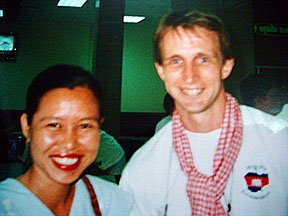 Negotiating the traffic - a multitude of mopeds, cyclos and bicycles jockeying with private cars and trucks - was a nerve-wracking experience, the loss of my suitcase at the ramshackle airport for three days was a nightmare but nothing could prepare me for my sobering visit to see the graphic reminders of the cruelty inflicted on the Cambodian people by the Khmer Rouge. At the Tuol Sleng Genocide Museum - a former high school turned into a torture centre and prison - my guide Kin (right) gave me a tour of room after room of torture implements, photographs and other evidence testifying to the atrocities of the Pol Pot-inspired regime. Ten kilometres outside the city are the 'killing fields' of Choeung Ek, where at least 17,000 people were taken from Tuol Sleng, brutally murdered and buried in mass graves. A memorial glass tower at the site is filled with the cracked skulls of some 8,000 of those victims and is definitely not for the squeamish. I left Cambodia with many lasting memories, enriched by my experiences and eager to return to this fascinating country in the not too distant future.
Negotiating the traffic - a multitude of mopeds, cyclos and bicycles jockeying with private cars and trucks - was a nerve-wracking experience, the loss of my suitcase at the ramshackle airport for three days was a nightmare but nothing could prepare me for my sobering visit to see the graphic reminders of the cruelty inflicted on the Cambodian people by the Khmer Rouge. At the Tuol Sleng Genocide Museum - a former high school turned into a torture centre and prison - my guide Kin (right) gave me a tour of room after room of torture implements, photographs and other evidence testifying to the atrocities of the Pol Pot-inspired regime. Ten kilometres outside the city are the 'killing fields' of Choeung Ek, where at least 17,000 people were taken from Tuol Sleng, brutally murdered and buried in mass graves. A memorial glass tower at the site is filled with the cracked skulls of some 8,000 of those victims and is definitely not for the squeamish. I left Cambodia with many lasting memories, enriched by my experiences and eager to return to this fascinating country in the not too distant future.
Anniversary
More news from the South Coast
Whoever says money can't buy happiness hasn't shelled out for their own beach in Cambodia. Before the crew of the Sea Breeze can even drop her anchor, Alexis de Suremain is in the water, swimming straight for 90 yards of white sand: his 90 yards of white sand. A wall of tangled jungle rises to the east; to the west, the sun sinks into its own reflection over the Gulf of Thailand. "See that?" de Suremain asks, waving at the sun as it bisects the beach view. "Right down the middle."If all goes according to plan, these 35 acres (14 hectares) of sand, rock and jungle will in a few years host a plush eco-resort of palm trees and solar-powered bungalows. De Suremain, a French expat who runs guesthouses in Phnom Penh, says he combed Cambodia's shores for three years before he settled on building his resort on the remote island of Koh Rong. "I wanted something where you couldn't hear karaoke, where the neighbor's dogs don't bark and where the cocks aren't crowing in the morning," he says. "I wanted something completely isolated." He's got it — for now.
The postcard-perfect beaches of Cambodia's scores of islands and 270 miles (435 km) of southern shore have gone largely unnoticed by developers for the past 40 years. But in 2007, a record 2 million tourists visited Cambodia, signaling that the country was beginning to shake its killing fields image as an impoverished backwater where wandering off the beaten path could mean finding yourself astride an unexploded land mine. Cambodia is starting to register as a must-see destination, and it's not all about Angkor Wat. Brackish mangrove swamps and remote beaches are being envisaged as golf courses and plots for five-star bungalows with private pools. Indeed, there are signs of vitality in other sectors of the impoverished country's once moribund economy. Cambodia's GDP grew 10.4% in 2006 — the highest rate in Southeast Asia that year — and foreign investment shot up some 400% to nearly $4 billion. Thirteen foreign companies, including Chevron, have licenses to explore Cambodia's offshore blocks for oil and natural gas; the government says domestic oil production could begin within three years. The rush for Cambodia's gold coast is on, raising hopes that the economic torpor of this aid-supported nation will finally end. "This part of the country has been a revelation for me," says Steve Smith, a Londoner who finances his endless summer as a dive instructor in southeast Asia. "I didn't even know there were beaches in Cambodia."
The Undiscovered Country
To witness this awakening up close, I recently borrowed a wreck of a bicycle for a slow ride through the sleepy Cambodian seaside town of Kep, near the Vietnamese border. After limping along the potholed coastal road past unkempt plots of oceanfront land with crumbling colonial-era manses, I stopped to look at a billboard — the only one in sight. On it was a picture of a home that would not have looked out of place in a Denver subdivision. A young man pulled up on a motorbike next to me. "You want to buy?" he asked. I told him I wasn't in the market, and so he handed me a flyer for his business, Sunny Tours, that bore a stern warning: NOW IS THE TIME TO ENJOY KEP!! Five years ago, Sunny Tours' catch-it-while-you-can marketing wouldn't have been very effective. In the early 20th century, Kep-sur-Mer was established as a getaway for French civil servants running the colony, and it served as an enclave for rich Khmer after independence in 1953. (The former King, Norodom Sihanouk, built a royal residence there that, like most of the old estates in town, now stands empty.) The holidays ended in the 1970s after an American bombing campaign brought the first wave of more than two decades of war, including the Khmer Rouge-led genocide that killed nearly 2 million Cambodians between 1975 and 1979.
Stability has been slow to return to Kep and to the country as a whole. But today nearly every Asian nation has a stake in Cambodian industries, from hydroelectric dams to oil exploration to real estate development. In Kep, three Modernist homes have been restored into Knai Bang Chatt, a striking boutique hotel owned by two Belgians. At the other end of town, the early 20th century La Villa de Monsieur Thomas is being revamped into a five-star resort by a Khmer developer. And in February, Sokimex, a powerful Cambodian company that imports most of the nation's petroleum, began converting a colonial casino on Bokor Mountain into a flashy new resort. "All of a sudden there's interest," says Joseph Mussomeli, the U.S. ambassador to Cambodia, who last year hosted the first American business conference in Phnom Penh. The country is "lucky to be stuck between 85 million Vietnamese and 65 million Thai," he says. "It's hard to ignore this place now."
More projects are in the works. About an hour's motorbike ride down a red dirt road that trails off the coastal highway, residents of the fishing village of Angkoal have started selling their small holdings to real estate developers. One family, residents of a palm-fringed knob of land that slopes into the water, says their property is regularly visited by speculators. "They come every day," says Sry Mau — even though the place where the young woman's family has lived for 23 years has already been purchased by a Cambodian hotelier for $8,000. With the money, they bought a new, considerably smaller piece of land across the road and a new fishing boat.
In a country where 4.7 million people live on less than 50 cents a day, the surge of investment is changing lives and could help create jobs. The country desperately needs more employment opportunities. About a third of Cambodians are 15 years old or younger, and they'll be entering the workforce in droves over the next two decades. Hundreds of NGOs are already busy trying to fix Cambodia, and about 20% of the government's total budget still comes from foreign aid. The prospect of a tourism boom coupled with the start of domestic oil production offers the tantalizing possibility of a more independent way forward. With foreign aid, "you'll always be living according to somebody else's rules," says Rithivit Tep, director of the private-equity firm that owns Kep's Thomas villa and development rights to two islands. "We have wasted a lot of time."
A few hours drive down the coastal road, I was sitting inside the dusty office of Sokun Travel and Tours when the lights cut out. "No good," said the woman behind the desk, looking into the dark street. "Every day, two or three times." We conducted the rest of our transaction by candlelight. Mourn Sokun, who owns the travel agency, says Sihanoukville, the current hub of south-coast tourism, can't keep up with the rush of tourists. The number of foreign visitors to the city shot up by 50% between 2006 and 2007, and infrastructure, including electricity generation, is overtaxed. In 2007, the local airport reopened to shuttle tourists between Angkor Wat and the coast, only to close months later when a domestic flight went down, killing 22 people on board. It's still closed today. Som Chenda, Sihanoukville's minister of tourism, says the city needs more of everything — more hotel rooms, more restaurants, more hospitality training, more language teachers. "We need it all," says Som. Right now, Sihanoukville doesn't even have enough fresh produce coming in: "There are too many tourists and not enough food."
In a line of work that relies on clean beaches and clear water, Mourn, the travel agent, worries the authorities aren't working hard enough to protect the environment. As more guesthouses and bars pay their license fees to operate at the popular beaches, Mourn says raw sewage is being piped into the water and trash is being dumped onto the sand. "People pay their money, and the government closes their eyes," Mourn says. Government officials say they are aware of the growing problem. "The coast is not so good now because of the fast development," says Prak Visal, who heads the Sihanoukville branch of a regional coastal-management project. Solid-waste dumping, mangrove destruction, unsustainable fishing practices and illegal logging are a few of the challenges he says the area faces. But slowing things down? Not an option. "We protect, but we develop, too," Prak says.
Though some are happy with the money they've made, others living in valuable areas fear they'll lose their land, or lose it without being fairly compensated. Few families hold formal land titles, leaving many to rely on local authorities to vouch for them as landowners if a developer comes calling. Though efforts to provide documentation for landowners have been ramped up — almost 1 million land titles have been granted since 2004, according to the World Bank — there are millions more to go. Cambodians' scramble to secure their rights speaks to a fundamental anxiety: faith in the law is dismally low. For the past two years, the country has ranked near the bottom of Transparency International's Corruption Perception Index, and in a 2007 World Bank study, only 18% of respondents said they thought judges were honest. "Corruption is so pervasive it's part of the culture," says Theary Seng, executive director of the Center for Social Development, a Phnom Penh-based NGO. She worries that the billions coming in from private investment — particularly in oil — will not trickle down to the countryside where 80% of the nation lives. "If they want to do it right, they have lots of good models in the world," says Mussomeli, the U.S. ambassador, warning against Cambodia going the way of oil-cursed nations like Nigeria and Chad. "Or they could do it wrong and they could suffer the political consequences in 20 years. This is their chance to be a real country. This is their chance to have a real economy. If they screw it up, they'll be a vassal state."
The Road Ahead
Alongside road 4, the 143-mile (230 km) ribbon of asphalt connecting Sihanoukville and Phnom Penh, water buffalo graze in rice paddies that stretch from horizon to horizon. Kids in white school uniforms pedal their bikes in the dirt, moving alongside traffic like birds riding on air currents. It's places like these — in other words, most of Cambodia — where the five-star visions of the coast begin to get a bit blurry. Neither tourism nor oil alone can drive the national economy in a meaningful way. There must also be investment in agriculture and other sectors that employ most Cambodians, says Arjun Goswami, country director for the Asian Development Bank. "If one of these days I can go into Whole Foods and see a Cambodian export on the shelves, that's when I'll be a happy man," says Goswami.
In Phnom Penh, I stop by the offices of Rory and Melita Hunter, an Australian couple whose real estate company was recently granted a 99-year lease to build a luxury boutique hotel on Song Saa, a tiny pair of islands off the coast. They show me elaborate renderings of the future 40-room complex, replete with a wine cellar, air-conditioned library and 15 over-water bungalows designed to reflect the architecture of a nearby fishing village. The Hunters paid relocation costs for the 15 or so families living on the islands. They hauled away tons of trash that had been piling up for years, and started to revive the local coral reef that had been all but destroyed by overfishing. "Knowing that there had been all these other issues about how people had been relocated, we wanted to do it properly from the start," says Rory Hunter. "We're going to be doing business here for a long time." Maybe money will buy happiness for Cambodia; maybe it won't. But nobody said paradise was built in a day.
BBC on the Tonle Sap
Saving Cambodia's Great Lake - by Philippa Fogarty, BBC News
Every May, when the rains come, water levels in the Mekong start to rise. When the river flows into Phnom Penh it meets another river that drains from a lake in central Cambodia. So full is the Mekong that it reverses that river's flow, forcing water back upstream and expanding the lake more than five-fold. This is the Tonle Sap, the largest freshwater lake in South East Asia. Cambodians call it the Great Lake. It is an area of extraordinarily rich biodiversity and a key breeding ground for fish, which migrate upstream from the Mekong to spawn in seasonally-flooded forest areas. The lake is vital to Cambodia. It provides two-thirds of the country's protein and more than one million people depend on it directly for their livelihoods. But the lake faces serious threats. Cambodia's population has risen rapidly and pressure on resources has increased. Fish stocks are threatened by over-exploitation and illegal fishing methods. Farmers and developers have taken advantage of weak governance to seize and drain land in the flooded forest, destroying key wildlife habitats and polluting the lake. More trees have been felled for domestic use by local people, some of whom have been hunting rare wildlife to compensate for smaller fish catches. Last year, Prime Minister Hun Sen warned of a "serious environmental disaster" if the problems were not addressed.
Fish sanctuary
The Asian Development Bank-financed Tonle Sap Environmental Management Project (TSEMP) is leading efforts to do that. Eight years ago, more than half the lots on the lake allocated to commercial fishing were released to local communities. Part of TSEMP's work is helping villages create legally-recognised community fisheries to protect and preserve their own resources. More than 170 of these groups have now been set up. Soer Tao is deputy head of the community fishery in Kampong Klaeng, on the lake's northeast shore. The village is home to about 10,000 people living in stilted houses to cope with the seasonal flooding. Some 85% of residents depend on fishing for their livelihoods. Ten years ago, Soer Tao says, illegal fishing and destruction of the forest were causing serious problems to villagers. But local management of resources is bringing benefits. The village boundaries have been formally set. Residents patrol the area and if people are fishing illegally or if developers are trying to encroach into the flooded forest, they should now be better positioned to tackle the problem. The village has also established a fish sanctuary, 300 metres by 30 metres, where fish can spawn during the dry season. It is marked by red flags and guarded at each end. When the flooding comes, the fish will swim out - hopefully in greater numbers every year. "The fish sanctuary will protect the fish as livelihoods for everyone," Soer Tao said.
New projects
But it is not just about protecting fisheries. Preak Toal is a floating village. Everything floats, even the school and the petrol station, and everyone depends on the lake to live. Now projects are being set up to help families diversify their livelihoods away from the lake in a bid to reduce pressure on resources. Former poachers patrol a biosphere reserve, guarding the rare water birds that they used to hunt. Tourists pay to enter and local families use pedalos to show the day-trippers around. Some residents have built floating gardens for fruit and vegetables, while others are growing mushrooms in their floating houses. One group is trying to turn water hyacinth into charcoal-like fuel. But the initiatives are, of course, not perfect. It is still much simpler for villagers to get firewood from the forests and to sell fish for quick profit.
'Turning point'
Dr Neou Bonheur, director of TSEMP, admits that trying to promote environmental awareness to those struggling to make a living can be difficult. "It is hard," he says, "but when we teach them not to cut the forest because it is a breeding ground for the fish, they see the benefits of that." The villagers, he says, are not the greatest challenge. "Now we are at a turning point - rice and fuel prices are up and there is a tendency to look for resources such as land, not from the communities but from outside groups who want to claim areas for development. "That's the most difficult thing for us, the people who damage the communities and fisheries in that way." Community resource management was put in place at the right time, he says, but it must be strengthened to ensure local people have a permanent voice. He describes efforts to date as "so far, so good", but says they must be sustained. "We cannot say it is now enough - we have to continue to work hard on many areas." But there is one key issue Cambodia cannot control. China, Thailand and Laos all want to dam the Mekong for hydropower, something experts say could have a serious effect on the seasonal influx of water and wildlife into the lake. "We are a downstream country and less powerful compared to upstream countries," says Dr Bonheur. "We can only hope that through dialogue, Cambodia can voice its concern. The Tonle Sap is a great asset for Cambodia. We must protect it at all cost."Theft of artifacts
Villagers Guard Their Own Antiquities - by Frances Suselo, Oct 2005
Reet, 14, grew up among the hilltop ruins of this district, about an hour's drive from the capital Phnom Penh and learned how to count by going up and down its 412 steps. It is also right here at the local school that he learned about the looting of antiquities from the 11th century temple, also called Phnom Chisor, at the top of the hill. But, he tells visitors, ''There is no looting here''. The community around the ruins runs a programme to educate villagers about the Phnom Chisor temple, made in Baphuon and Khleang architectural style and from laterite and sandstone. Jutting out to the sky from the 100-metre hill, Phnom Chisor was built by Suryavarman I, the king of the Khmer Empire, for the god Brahma in 1010. The Angkorian temple is more or less intact, unlike many other ruins, such as Koh Ker, capital of the Khmer kingdom in the 10th century, and even parts of Angkor Wat in Siem Reap province.
Looting is often done by poor villagers who sell the artefacts for small amounts, these then find their way to local or international markets, activists say. International auction houses do not make enough efforts to ensure items are not obtained illegally, argues Dougald O'Reilly, founder and director of Heritage Watch, a Phnom Penh-based non-government organisation. An ancient looted bead would probably bring a local a mere one US dollar, then could be sold for a hundred times the amount in a Bangkok market - and much more outside Asia, says Terressa Davis, project coordinator of Heritage Watch. Meantime, Reet says that Cambodian law forbids the looting of the country's antiquities. What would he do if someone offers him a lot of money for something from the ruins? His eyes blazed as he answered, ''I won't do it because it's illegal. Besides, I know it's a bad thing to do''. "Officers from the Ministry of Culture have made it very clear that looting is prohibited. People are more informed now, so they will not be tempted to loot,'' said a monk at a modern Buddhist temple beside the ruins. ''We all have the duty to protect our own cultural heritage''.
The total value of cultural assets, both counterfeit and original, smuggled each year is around 22 million dollars, O'Reilly quotes Masayuki Nagashima, the author of 'Lost Heritage: the Reality of Artefact Smuggling in Southeast Asia', as saying. Worldwide, trafficking in stolen works of art and national treasures is valued at up to eight billion dollars a year, according to the Art Theft Programme of the U.S. Federal Bureau of Investigation, which calls the trade ''a major category of international crime''. Interpol says that the annual dollar value of art and cultural property theft is exceeded only by trafficking in illicit narcotics, money laundering and arms trafficking. The looting of artefacts also means the loss of crucial information about the past: social and political structures of society, pre-historic health, ancient technologies, records of border trade as well as art and architecture. Many other Asian countries experience differing degrees of looting. But the popularity of Khmer artefacts, porous borders and lack of resources add to the problems in Cambodia.
Activists admit it is hard to curb the demand in the trade in stolen antiquities. So, groups like Heritage Watch focus on education campaigns to prevent looting or encourage communities to protect their heritage by training villagers to develop new skills, such as managing small businesses and producing crafts to sell to tourists. But Davis says 80 percent of the catalogues of international auction houses have no provenance - information on items' origins - and this does not help efforts to protect Cambodia's heritage. ''They can simply say that a vase is done in Ming style, but they won't say where exactly they got it from,'' said Davis. ''The absence of provenance could mean either they really don't know where the item came from, or the information could be incriminating. People assume that because they are big companies, they follow the law, when in fact they are operating under a very thin veil of decency,'' she added.
But Wannida Saetieo, country manager of Sotheby, Thailand, said the company is a ''proper public company'' that has always followed the law. ''At Sotheby's, we always try our best to ensure that all items are genuine and not acquired through illegal means,'' she said in an interview. Before an item can be sold through Sotheby's, the owner must show documents certifying ownership, she added, but conceded the company ''cannot guarantee 100 percent that an item is not stolen. If we know that there is only one item and that the item is in a museum somewhere and if someone comes with an item that looks alike, then we know it's a fake,'' she stated. But ''it's the responsibility of the buyer to also do their own background check on any item,'' she added, flipping over a Sotheby magazine to its back pages to show the company's disclaimer. Wannida also stressed that Thailand forbids the bringing of Buddha statues out of the country. ''There is a big demand for them, but we don't sell them because it's illegal,'' she explained. Wannida said that provenance on Sotheby's catalogues can be absent because wealthy owners guard their privacy and prefer not to see their names printed for the whole world to see. ''These people are very, very private,'' she stated.
National and international laws and conventions exist to make theft and trafficking harder, but they are not always adequate. In 1996, Cambodia's National Assembly adopted the law on the Protection of Cultural Heritage, which covers ''movable and immovable objects and cultural property from vandalism, illicit transfer of ownership, excavations, illicit export and import''. In the same year, Cambodia claimed all cultural properties for the state, making the selling of Khmer antiquities illegal. But to recover a stolen artefact, the government has to prove theft by producing a picture of the item in its original site before it was stolen. Most pictures of Khmer antiquities in their original sites were taken in the 1930s by the French, so this loophole has added to the difficulty in prosecution.
Stolen Khmer artefacts are usually smuggled out either by sea to Singapore, or by land to Poipet, a Cambodian town on border with Thailand, said O'Reilly. Smugglers take advantage of the fact that Singapore and Thailand are not signatories to the 1970 UNESCO convention that prohibits the import of stolen cultural property and requires countries to monitor the antiquities trade within their own borders. Cambodia is also a signatory to the 1995 UNIDROIT Convention on Stolen or Illegally Exported Cultural Objects, which declares that ''a possessor of a stolen cultural object must return it regardless of personal involvement or knowledge of the original theft''. This allowed the Cambodian government to negotiate with Thailand in 2001 and 2002 for the restitution of 43 Cambodian cultural artefacts, which had transited through Singapore. A 9th century stone head of Shiva and a 12th century stone head of a demon were also returned by the Honolulu Academy of Arts in 2002.
For now, small teams of local experts from Heritage Watch continue documenting Cambodia's ruins, so there is visual evidence in case some artefacts go missing and turn up somewhere halfway around the world. These teams also use illustrated comic books in Khmer to explain why villagers should protect their temples and ruins. Heng Chan Thol, a former student of the Archaeology Department of the Royal University of Fine Arts in Cambodia, agrees: ''Poverty alleviation and education should be the main efforts to get rid of this phenomenon''. For instance, ''the Apsara Authority, in charge of protection and preservation of Cambodian cultural heritage has tried bringing local people to work as guards for local historical sites. As a result, the looting in Siem Riep (Angkor Wat) has almost completely disappeared,'' he said. ''One day, they will be held accountable,'' Davis said of traffickers in stolen antiquities. ''Art collectors, looters and smugglers will face the same discrimination as those who profit from ivory and fur today''.
Serious monkey matters
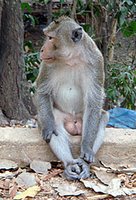 A male macaque monkey was shot dead yesterday morning by police at Wat Phnom, following a series of attacks on visitors to one of Phnom Penh's key attractions. It's a problem I highlighted a while back after I experienced some unruly monkey behaviour and gnashing of teeth at Phnom Chisor, as I called it then, "an accident waiting to happen." At some of the key 'touristy' pagodas you can often find a troop of monkeys, attracted by the potential for food scraps raised by the increased level of visitors. An M-16 assault rifle was used to kill this particular 20kg monkey after a local man received bites to the head, both hands and legs whilst jogging in the immediate vicinity of the park surrounding the hilltop pagoda. The police are now deciding whether to catch some of the more vicious monkeys and transfer them to Phnom Tamao Zoo. However, when I visited the zoo, there were more monkeys outside the cages than inside, so I'm not convinced that's the long-term answer.
A male macaque monkey was shot dead yesterday morning by police at Wat Phnom, following a series of attacks on visitors to one of Phnom Penh's key attractions. It's a problem I highlighted a while back after I experienced some unruly monkey behaviour and gnashing of teeth at Phnom Chisor, as I called it then, "an accident waiting to happen." At some of the key 'touristy' pagodas you can often find a troop of monkeys, attracted by the potential for food scraps raised by the increased level of visitors. An M-16 assault rifle was used to kill this particular 20kg monkey after a local man received bites to the head, both hands and legs whilst jogging in the immediate vicinity of the park surrounding the hilltop pagoda. The police are now deciding whether to catch some of the more vicious monkeys and transfer them to Phnom Tamao Zoo. However, when I visited the zoo, there were more monkeys outside the cages than inside, so I'm not convinced that's the long-term answer.
Unprecedented collaboration
Iconic imagery at Banteay Chhmar
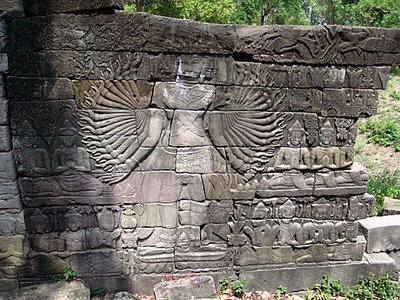 One of two remaining multi-armed Avalokiteshvara at Banteay Chhmar. This one has 32 arms and is surrounded by worshippers and flying apsaras
One of two remaining multi-armed Avalokiteshvara at Banteay Chhmar. This one has 32 arms and is surrounded by worshippers and flying apsaras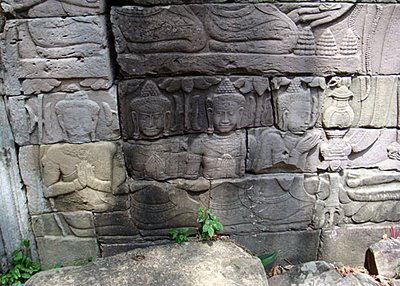 In the middle and lower register next to the 32-armed Avalokiteshvara are crowned worshippers in anjali meditation
In the middle and lower register next to the 32-armed Avalokiteshvara are crowned worshippers in anjali meditation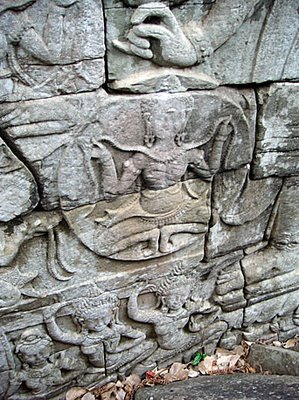 A large medallion with an apsara holding a ribbon of pearls and more apsaras below her. Note the hand and crooked finger above her head
A large medallion with an apsara holding a ribbon of pearls and more apsaras below her. Note the hand and crooked finger above her headThe two Avalokiteshvara still on view at Banteay Chhmar are the 32-armed example with eleven visible heads, standing on a lotus in the middle of an assembly of kneeling worshippers in a state of anjali, and one with 22 arms and seven eroded heads. Apsaras or devata in ten large medallions surround the main figure. These images are a key attraction at Banteay Chhmar and the temple authorities must take care that they are treated with respect by visitors - on a previous visit, I observed graffiti carved on one of the figures. Banteay Chhmar is a remote site though funding and recognition is slowly being channelled towards the temple and the early fruits of minor restoration work can be seen at the temple's entrance. It's certainly one of my favourite temples in Cambodia.
Thursday, May 29, 2008
Farewell to Kompong Khleang
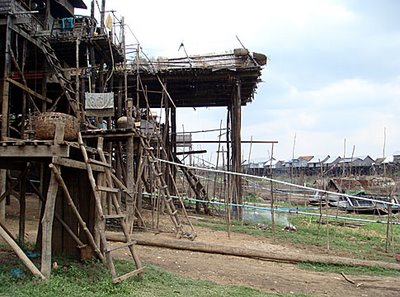 The water level in the wet season will mean that the stilts of these houses will disappear
The water level in the wet season will mean that the stilts of these houses will disappearInside the stilted village
River views
Wednesday, May 28, 2008
Cambodia's soccer success
Anyone have a spare house?
Link: CLA.
Nat Geo on Mondulkiri
Tigers, Elephants Returning to War-Torn Cambodia Forest - by Stefan Lovgren in Mereuch, Cambodia for National Geographic News
For years wildlife poacher Lean Kha had prowled the war-ravaged forests of Mondulkiri Province in eastern Cambodia looking for meat. A former teenage soldier for the Khmer Rouge political party, he estimates that he killed a thousand animals, including ten tigers, after the fall of the brutal Pol Pot regime in 1979. Once dubbed the "Serengeti of Asia," almost all of Mondulkiri's wildlife was wiped out by poachers during decades of conflict, which began with the war in neighboring Vietnam. Now, with Cambodia finally at peace, small but growing populations of animals—including Indochinese tigers, Asian elephants, and critically endangered species such as the giant ibis—are returning to one of Southeast Asia's last remaining dry forests. And Kha, now 45 years old, is helping to protect them as a head ranger supported by the international conservation group WWF. "At the time I was ignorant and did not think there was a problem when I shot those tigers," he said, sitting at the forest headquarters in Mereuch as the Srepok River rushed behind him. "Now I know we need to protect these animals for our children and grandchildren."
Coming Back Home
Humans cannot live inside the protected Mondulkiri Protected Forest reserve. A visitor can walk for miles without seeing any sign of humans, an unusual experience in otherwise densely populated Cambodia. And with the region's searing summer temperatures and open, shadeless terrain, it's also usually hard to spot wildlife during the day. But camera traps that take pictures at night show a different story. A few years ago park rangers caught their first Indochinese tiger on camera. In 2007 a camera trap produced a picture of a female leopard and her cub. Other wildlife returning to the area include banteng, a type of ox; Eld's deer; several species of wild cats; and one of the region's last remaining wild water buffalo populations. "There is a lot of wildlife out there, considering the beating that this area has taken," said Nick Cox, who coordinates WWF's regional dry forests program and is based in Vientiane, Laos.
While leopards are now relatively common, there may be only five to ten Indochinese tigers in the forest today. But conservationists say that as the density of prey species increases, the number of tigers could rise to at least 30 in as little as five years. That is, if the 70 rangers working the forest can keep poachers at bay. Like Kha, many of them are former hunters who have spent their whole lives under the forest canopy. Now they spend at least 16 days on patrol every month, keeping strict records of wildlife numbers. "All protected areas need to know the number of important prey species and carnivores, because if we don't know the credit in our bank account, we can't monitor our wealth," said Prach Pich Phirun, a research coordinator for WWF's Srepok Wilderness Project.
Cambodia Boomtown
Even without the threat of poachers, the battle for this vast forest of almost a million acres (close to 400,000 hectares) is far from over. Cambodia's popularity as a tourist destination is skyrocketing, with foreign tourist arrivals topping two million last year, according to the country's tourism minister. And the remote Mondulkiri Province is becoming the country's new hot spot. Draped over several rolling hills, Sen Monorom, the tiny provincial capital, has the feel of a Wild West boomtown. A plethora of hotels and backpacker lodges have opened up, and wealthy Cambodians are streaming to the area to snap up any available land. The main road being graded and paved by Chinese contractors will ease access to the region. "This increased activity could put a lot of pressure on the environment," said Craig Bruce, WWF's technical advisor on protected areas in Cambodia, who is based in Sen Monorom. A housing building boom, he warned, could also lead to a surge in illegal timber cutting. And there are signs that poaching and illegal wildlife trade are on the rise in Cambodia, where animals are being smuggled through Vietnam with the involvement of Chinese traders.
Ecotourism Plans
Conservationists are now investing in ecotourism projects in the hopes of keeping the Mondulkiri forest protected. WWF is planning an upscale eco-resort with eight cottages along stilts on the banks of the Srepok River. Yet money earned from such eco-projects must benefit local communities living around the forest, said James MacGregor, an environmental economist at the London-based International Institute for Environment and Development, which backs the WWF project. "There are a lot of poor people in this area who have traditionally generated their livelihood through hunting and collecting wood," MacGregor said. "We're asking people to forgo doing something that has helped them for years." Planners envision that Mondulkiri could also become a destination for adventurous travelers, such as mountain bikers. Mark Ellison of Cambodia-based Asia Adventures said tour operators are looking to offer tourists additional activities in Cambodia besides visiting the popular Angkor Wat temples. "Here's an opportunity to go mountain biking in an area that is for all intents and purposes undiscovered," he said.
While a recent bicycle trip of conservationists and journalists showcased the unchartered nature of the terrain, it also turned into a harrowing ordeal at one point, with bikers getting lost without any means of communication. Luckily a passing elephant driver had noticed tire tracks from the bikes going the wrong way and tracked down the team just as its water supply was running out. Cox, the WWF dry forest program coordinator and one of the most experienced bikers on the trip, admitted that some work needed to be done before Mondulkiri would be ready to welcome visitors. "There are a few kinks that need ironing out, that's for sure," he said. Link: Read about my adventures in March
Tuesday, May 27, 2008
Would you Adam & Eve it!
 Cockney rhyming slang for 'would you believe it,' as Roy Hill pulls the proverbial cat out of the bag and walks away with the May Competition Award at the West London Song Contest. Fame at last! It was only the second monthly event to be held and it was such a success, all further shows have been cancelled. I reckon the organizers realized no-one could ever match the brilliance of a Roy Hill performance. An event for singer-songwriters, the Castle pub in Isleworth was the stage for Sunday's jamboree where five entrants performed two of their own songs. The audience and two judges voted for their favourite and Roy clinched the vote - of course, it was never in doubt - and he got to play a 30-minute set as a reward (as well as take home a cash prize of 40 British Pounds no less). I need to speak to the man himself to get the low-down on this extravaganza, but this success is surely a stepping-stone to fame and riches, I can see it all now. Pass me the sick-bag, I'm overcome with emotion. Link: Roy Hill.
Cockney rhyming slang for 'would you believe it,' as Roy Hill pulls the proverbial cat out of the bag and walks away with the May Competition Award at the West London Song Contest. Fame at last! It was only the second monthly event to be held and it was such a success, all further shows have been cancelled. I reckon the organizers realized no-one could ever match the brilliance of a Roy Hill performance. An event for singer-songwriters, the Castle pub in Isleworth was the stage for Sunday's jamboree where five entrants performed two of their own songs. The audience and two judges voted for their favourite and Roy clinched the vote - of course, it was never in doubt - and he got to play a 30-minute set as a reward (as well as take home a cash prize of 40 British Pounds no less). I need to speak to the man himself to get the low-down on this extravaganza, but this success is surely a stepping-stone to fame and riches, I can see it all now. Pass me the sick-bag, I'm overcome with emotion. Link: Roy Hill.
Modernist structures still on view
More holy faces
Baku exhibition
Monday, May 26, 2008
Apathy on and off the pitch
Cheeky monkey
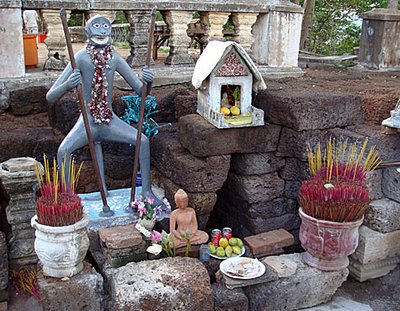 One of my favourite shrines at Phnom Oudong, and there are many, is this one showing a large and cheeky-looking monkey, just before you reach the main series of royal family stupas at the summit of the mountain. Its next to a large collection of laterite building stones that would suggest the former presence of an ancient prasat at the site (to coincide with other finds of pedestals and lintels in other locations), or that these blocks were used for construction of the stairways leading to the top. Without an expert archaeologist on hand I couldn't confirm either way and no-one knew the name of the monkey either. If you know the name of this popular shrine, please let me know. What I'd like to know is what the troop of monkeys that inhabit Phnom Oudong feel about this grey-coloured cousin of theirs. Do they worship him too?
One of my favourite shrines at Phnom Oudong, and there are many, is this one showing a large and cheeky-looking monkey, just before you reach the main series of royal family stupas at the summit of the mountain. Its next to a large collection of laterite building stones that would suggest the former presence of an ancient prasat at the site (to coincide with other finds of pedestals and lintels in other locations), or that these blocks were used for construction of the stairways leading to the top. Without an expert archaeologist on hand I couldn't confirm either way and no-one knew the name of the monkey either. If you know the name of this popular shrine, please let me know. What I'd like to know is what the troop of monkeys that inhabit Phnom Oudong feel about this grey-coloured cousin of theirs. Do they worship him too?
Inside Angkor National Museum
Sunday, May 25, 2008
18 Cubit Buddha
A mix of faiths
Bones of Buddha
As well as the bones of Buddha, a room underneath the chedi contains the Tripitaka - the written canon of Theravada Buddhism - and 3770 different-sized Buddhas donated by visitors from numerous countries. This room is only opened on special occasions. It stayed closed for my visit. I visited the site on a Sunday and there were a large number of people paying their respects and having their photograph taken at the shrine. You also had to take your shoes off to walk near the chedi. The views from the balcony surrounding the stupa are memorable. Below is a photo of a centre of Buddhist meditation that is located at the foot of the mountain and clearly shows that Buddhism in Cambodia is not short of money, with more buildings being erected at the site.
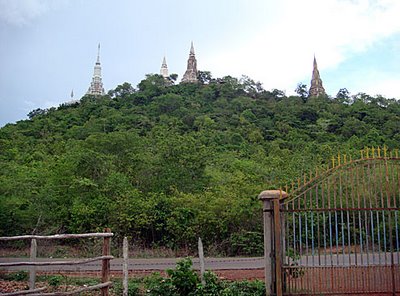 This photo of the largest ridge at Phnom Oudong shows the Sanchak Mony Chedi on the left and three other large stupas containing the ashes of former Kings of Cambodia.
This photo of the largest ridge at Phnom Oudong shows the Sanchak Mony Chedi on the left and three other large stupas containing the ashes of former Kings of Cambodia.Quiz answers
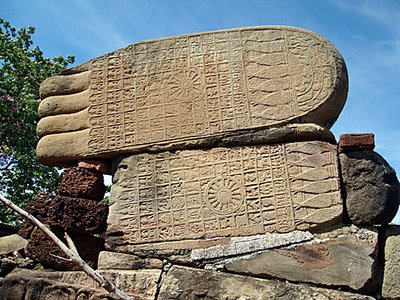 These gorgeously carved feet belong to Buddha, well actually, a statue of him. They can be found, alongwith the broken remains of his sandstone and laterite body at a shrine called Neak Pean, which is on a small hillock shared with a Muslim mosque called Vihear Cham Ta San. As you climb towards the top of the largest ridge on Oudong mountain, its the small rise on the left-hand side. Alongside the broken remains of Buddha and some headless worshippers is a large stupa containing the ashes of Preah Bat Chan Reachea. The term Preah Bat refers to the way you address a King, ie. you look at his feet!
These gorgeously carved feet belong to Buddha, well actually, a statue of him. They can be found, alongwith the broken remains of his sandstone and laterite body at a shrine called Neak Pean, which is on a small hillock shared with a Muslim mosque called Vihear Cham Ta San. As you climb towards the top of the largest ridge on Oudong mountain, its the small rise on the left-hand side. Alongside the broken remains of Buddha and some headless worshippers is a large stupa containing the ashes of Preah Bat Chan Reachea. The term Preah Bat refers to the way you address a King, ie. you look at his feet!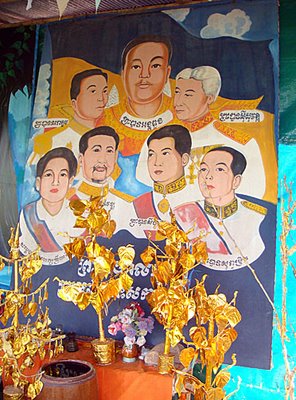 This painting at Neak Pean represents the Cambodian Royal Family, as you may've guessed. Beginning on the top row, left to right, are: King Norodom, Ang Duong and Sisowath. On the bottom row, left to right, are: Queen Sisowath Kosamak, Sisowath Monivong, Norodom Sihanouk and Norodom Suramarit. This painting is part of a shrine dedicated, as much of Oudong is of course, to the royal family.
This painting at Neak Pean represents the Cambodian Royal Family, as you may've guessed. Beginning on the top row, left to right, are: King Norodom, Ang Duong and Sisowath. On the bottom row, left to right, are: Queen Sisowath Kosamak, Sisowath Monivong, Norodom Sihanouk and Norodom Suramarit. This painting is part of a shrine dedicated, as much of Oudong is of course, to the royal family.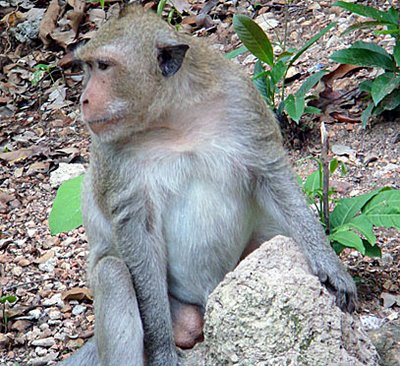 This male monkey was in charge of a large troop of monkeys to be found on the 509 steps leading to the new Preah Sanchak Mony Chedi built to house Buddha's relics, on Oudong mountain. He was a particularly bold monkey who chased away a large dog who got too close to his harem. I kept my distance.
This male monkey was in charge of a large troop of monkeys to be found on the 509 steps leading to the new Preah Sanchak Mony Chedi built to house Buddha's relics, on Oudong mountain. He was a particularly bold monkey who chased away a large dog who got too close to his harem. I kept my distance.
Saturday, May 24, 2008
The Fringe awaits Khmer dance
Stamp of approval
US Ambassador visits Eastern Plains of Cambodia
For the first time since the US government began its support of conservation work in the Cambodian Eastern Plains Dry Forest, a senior US government delegation saw for themselves how their investments have been used to support a wide range of conservation activities. US Ambassador Joseph A. Mussomeli, US Embassy staff, together with a group of Cambodian journalists, spent three days in March with WWF’s project staff and field rangers in the heart of the Dry Forests in Mondulkiri province. “I was very impressed with WWF’s efforts to protect Cambodia’s forests and wildlife while working to improve the livelihoods of the local people through the sustainable use of natural resources,” said Joseph A. Mussomeli in a letter of appreciation to WWF.
Significant investments through WWF in wildlife monitoring, law enforcement, community-based natural resource management and infrastructure development have built a foundation for effective protected area management in the Eastern Plains’ Mondulkiri Protected Forest (MPF) and Phnom Prich Wildlife Sanctuary. These have resulted in reduced pressure on wild animals and their natural habitats, improved understanding by the local community about sustainable use of natural resources, and strengthened land tenure and rights. Some of the approaches and lessons learned are now being replicated elsewhere in Cambodia and the region.
Ambassador Mussomeli was also interested by the ecotourism planning inside MPF as a critical element for sustainable financing for protected area management, and as a way to reduce local community dependence on natural resources. On this exciting component of the project’s work, Craig Bruce, Eastern Plains Landscape Project Manager, explained that “WWF involves community members living in the areas around MPF in ecotourism planning and in the hope that this will create future income opportunities through the provision of guide services, food, home stays, and sales of souvenirs to tourists.” This recent visit indicates a healthy relationship between the Cambodian and US governments, showing that there is support being given to conservation activities in the area. The Ambassador’s visit not only encourages our project staff and government counterparts, but also helps spread wider awareness of the important conservation work that WWF and the Cambodian government are working hard to achieve,” he said, “including a greater realization that there are significant challenges to overcome, such as poorly planned infrastructure development and resource extraction, illegal hunting, uncontrolled logging, and potentially harmful hydropower dam development plans.”
WWF is working together with the Cambodian government and other NGO partners to find sustainable solutions for development plans with the aim of minimizing environmental impacts. Other initiatives, such as ecotourism development, are aimed at improving local livelihoods and generating much needed revenue for overall development of the local economy. One of the next steps will be to generate political support for transboundary collaboration between Cambodian and Vietnamese authorities in order to safeguard the biodiversity of this globally important Dry Forests landscape.
More on Preah Vihear
Tranquil temple at center of a storm - by Philippa Fogarty (BBC News)
The view from the top of Preah Vihear temple is well worth the steamy, uphill trek to get there. Stone steps and paths lead visitors through a series of ancient entranceways to the carved sanctuary high in the Dangrek mountain range. Look one way and a Thai flag flies on a distant rocky outcrop. Turn the other way and the cliffs fall sharply down to the blue-green Cambodian jungle below. At the top, the only sound is of cicadas and dragonflies. Lower down, in a market with a frontier feel to it, vendors sell gems and rare animal parts. Things were good these days, one vendor said. The temple was open and visitors were coming. "The war is over," he smiled. But the temple has not always been so accessible, or so peaceful. Bullet holes scar one stone wall, while to the side of another stands a rusting artillery gun. Further down, both Cambodian and Thai guards maintain a low-key presence. These are reminders that bitter battles have dominated Preah Vihear's recent history - and that one of them is still being fought today.
Court ruling
Preah Vihear was built mainly in the 11th and 12th centuries when the Khmer empire was at its height, its construction ordered by the kings that commissioned the temples of Angkor. According to Sanskrit inscriptions, it was called Sri Sikharisvara, meaning Glorious Lord of the Mountain - a dedication to the Hindu god Shiva. It sits on a mountain-top promontory, facing north towards Thailand. The main access comes from the Thai side, because of the sheer cliffs behind it. Cambodian ownership of the temple was first formally established in boundary settlements between its colonial ruler, France, and Siam, as Thailand was then known, a century ago. A joint commission in 1904 set the border between the two countries atop the Dangrek mountain range - but its subsequent map, in 1907, put Preah Vihear in Cambodia. In 1954, shortly after Cambodia achieved independence, Thai forces occupied the temple. In response, Cambodia took its case to the international courts. Thai authorities argued that as the border was supposed to follow the watershed line of the mountains, the temple was theirs. They had not challenged the map, they said, because their access to the site gave them de facto control over it. But the court ruled against Thailand and in 1962, the Thai troops withdrew.
More trouble was in store for Preah Vihear as conflict engulfed Cambodia. With its hill-top location, it was the last place to fall to the Khmer Rouge in 1975. Four years later, when a Vietnamese invasion swept the Maoist regime from power, it was one of the strongholds to which the Khmer Rouge retreated. Years of fighting followed. Government forces managed to reopen the temple briefly in 1992, but Khmer Rouge guerrillas soon seized it back. Scores of fighters holed up in reinforced bunkers and held the complex for six more years. But the Khmer Rouge was on its last legs, its leaders dead or defected. In December 1998 the commander of the last group of fighters met negotiators at the temple to agree a historic surrender - one that ended three long decades of civil war.
Unesco row
Preah Vihear could finally be reopened. Landmines were cleared and paths made safe. Visitors began to return, market traders set up stalls and there was talk of much-needed restoration work. But the sovereignty row lingered on. In late 2001, Thai troops blocked access for a more than a year in a row over polluted water at the site. Since then, it has stayed open, but the issue remains extremely sensitive - as Cambodia's application to have Preah Vihear listed as the country's second Unesco World Heritage site has shown. "Becoming a Unesco World Heritage Site would bring international recognition to the Preah Vihear temple, especially the recognition of its universal value," says Ty Yao, president of Cambodia's National Authority for Preah Vihear. The added prestige would bring technical assistance from Unesco and other donors, he says, while the listing would formalise Cambodia's obligations in terms of managing and maintaining the site. It could also be a boon to the tourism industry, Cambodia's second biggest foreign currency earner, particularly given work to improve access from inside Cambodia.
But there is a problem. Although the international courts settled the row over the temple itself, the surrounding land remains the subject of overlapping territorial claims. Thailand says it would not object if Cambodia applied to list the temple area only. But it says Cambodia has, in its submission to Unesco, included disputed territory within the listed zone. It wants both countries to jointly manage the disputed areas until the border is agreed - and last month, sent a formal protest to Cambodia accusing it of deploying troops and mine clearers in a mutually-claimed area. Senior officials from the two countries are due to meet at Unesco headquarters in Paris today in a bid to iron out the dispute. "We would like to reach a win-win agreement," The Bangkok Post quoted Thai Foreign Minister Noppadon Pattama as saying ahead of the meeting. "We will try to be more flexible." Preah Vihear is not about to fall down - it has already survived a great deal. It is a staggeringly beautiful reminder of the area's turbulent past. Perhaps soon it will be known only for this beauty, rather than for the battles fought over it for so many decades.
Off-limits
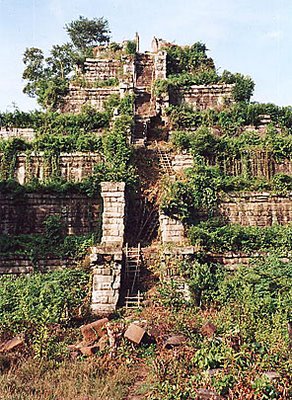 This is Prasat Thom, the pyramid temple at the complex of Koh Ker, a couple of hour's drive from Siem Reap. It doesn't look like this anymore as it's been cleaned up - this photo was taken in November 2001 when only serious adventure tourists were visiting the site. However, as I reported a while back, the pyramid is now off-limits to tourists after one of the larger blocks at the top of the 36-metre high structure fell onto the ladder, making it unsafe for visitors. The site is known for its giant lingas and Prasat Thom is believed to have housed the largest of them all at its summit, though the search is on to find fragments of it. As visitors to Angkor Wat will already be aware, the top of that monument is also off-limits at the moment too. It's not clear when the upper level of Angkor Wat will be re-opened.
This is Prasat Thom, the pyramid temple at the complex of Koh Ker, a couple of hour's drive from Siem Reap. It doesn't look like this anymore as it's been cleaned up - this photo was taken in November 2001 when only serious adventure tourists were visiting the site. However, as I reported a while back, the pyramid is now off-limits to tourists after one of the larger blocks at the top of the 36-metre high structure fell onto the ladder, making it unsafe for visitors. The site is known for its giant lingas and Prasat Thom is believed to have housed the largest of them all at its summit, though the search is on to find fragments of it. As visitors to Angkor Wat will already be aware, the top of that monument is also off-limits at the moment too. It's not clear when the upper level of Angkor Wat will be re-opened.
Friday, May 23, 2008
Prediction time
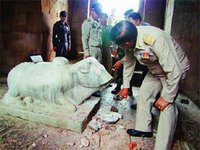 Vandals in Thailand have caused damage to ancient statues at Prasat Phnom Rung and moved the Shiva Linga stone at the centre of the temple site off its plinth. Heads of eleven nagas at the stairs to the temple had been broken off. A sacred cow (right), two statues of singha and a statue of the guardian deity at the entrance were also damaged, though only two of the sculptures were originals, the rest were replicas. Theories about who did the damage to the 10th century temple abound but no-one has claimed responsibility and the authorities are no further forward in solving the puzzle. Suggestions that Khmer sorcerers are to blame will do little good to Cambodian-Thai relationships, already fraught over the long-running Preah Vihear saga. Phnom Rung is renowned for its quality of architectural decoration and was restored to its current state between 1972 and 1988.
Vandals in Thailand have caused damage to ancient statues at Prasat Phnom Rung and moved the Shiva Linga stone at the centre of the temple site off its plinth. Heads of eleven nagas at the stairs to the temple had been broken off. A sacred cow (right), two statues of singha and a statue of the guardian deity at the entrance were also damaged, though only two of the sculptures were originals, the rest were replicas. Theories about who did the damage to the 10th century temple abound but no-one has claimed responsibility and the authorities are no further forward in solving the puzzle. Suggestions that Khmer sorcerers are to blame will do little good to Cambodian-Thai relationships, already fraught over the long-running Preah Vihear saga. Phnom Rung is renowned for its quality of architectural decoration and was restored to its current state between 1972 and 1988.
Quiz Time
Tuol Sleng recalled
Thursday, May 22, 2008
Die Angkar
Tonight I went to the Meta House for their German film night, attended by no less a mortal than the German Ambassador and his wife, in their civvies. The film was the second of the ground-breaking documentaries by East German filmmakers Walter Heynowski and Gerhard Scheumann, who were one of the first reporting crews to get access to Cambodia after the expulsion of the Khmer Rouge from power in the spring of 1979. Die Angkar focused on the Khmer Rouge and their communist roots and included never-before-seen early footage from Tuol Sleng and Choeung Ek, including interviews with survivors like Vann Nath and Ung Pech. Fascinating stuff, though it was in German so I didn't understand a word! They showed literally hundreds of mug-shots from the Tuol Sleng archives to press home their point during the 90-minute film. They also included an interview with Ieng Sary - who alongwith Pol Pot was tried in absentia as the two main architects of the genocidal Khmer Rouge regime - to complement the interview with his wife Ieng Thirith in their other unique film, Kampuchea : Death and Rebirth, which screened at Meta House a few weeks ago. Both films are a unique look into Cambodia in those early months after the KR were kicked out of Phnom Penh. Whilst their focus is skewed, the footage alone makes them compelling watching.
A bit later I finally encountered the only expat football team in Phnom Penh of any note. Members of the Bayon Wanderers team were having a beer and talking football in my local, the Red Orchid when I walked in. I've been trying to get in touch with them since I arrived in Phnom Penh but without success, until now. I'm seriously thinking of getting fit again and a kickabout with these guys would do the trick. They tell me they're in a local league and play games against Khmer opposition every weekend. Having not kicked a ball in anger for about five years, I am embarrassingly out of shape, but maybe this is exactly what I need to rekindle my fitness and my thirst for live football.
Pass It On
1. What's this illustration for?
My new book with Sara Bednark who is the writer. Wally's Bedroom aviary.
2. Do you have to wait for a flash of inspiration - how do you start?
The text gives me a vivid imagination & inspiration and then I feel I can to start.
3. How did you get your start as an illustrator?
I was a political editorial cartoonist from Cambodia (1970-1975). I arrived here in May 1980 and have been living in Brisbane. I worked at the Migrant Education Centre as an Illustrator after I finished my 3 months English course. Then I moved to Sydney to live and have worked since then as a film animator, Layout Artist and storyboard artist with several animation studios such as Burbank, Hanna Barbera, Walt Disney, Yoram Gross and Energy Intertainment.
I was a freelance editorial cartoonist for the magazine Far Eastern Economic Review (Hong Kong, 1997-1999). Recently (2007) I worked for Compass, a South Korean publishing company that produces educational books for migrants in the US. I worked on my first children’s book with Sara Bednark who is the author. My second is about Cambodian folktales: "The Sightless & The Hobble". And the third book is on the road: "The Cat & The Cricket." It is about geography & history of some famous countries around the world.
4. Who or what has influenced your work?
Asterex of Uderzo, French comic book artist, and Tintin. I learned to draw cartoons from those books while I was a Fine Arts student (1965-1975). And also I was influenced by one of my teachers, Dimitri, a great Russian painter & cartoonist.
5. What's your favourite media for creating pictures?
I draw in Black and White and scan and paint with the Photoshop digital. I think it's the best tool.
6. What's the worst thing about being a freelancer?
The worst thing is that I have to wait to get work.
7. And the best?
The best is my freedom. From my experiences as a Freelance Artist who has worked from home for 20 yrs, I enjoy my own space & time and it's the best thing in my life as father of 4 kids. I have been able to drop & pick them up from school, cook for them after school and spend a lot of time to see them grow up in a happy & harmonious environment.
8. What are you working on at the moment?
I'm working on my third book with Sara Bednark, who is living another world away from Australia in Oregon USA.
9. Where can we see more of your work?
Our first book: "Wally's bedroom aviary" is available for purchasing at Lulu.com.
I have 3 sites where you can see my children’s book illustrations & my political toons. Because the sites are so different I call myself: "Dr Jacklyn and Mr Hyde".
www.karmatoons.blogspot.com
www.poltiktoons.blogspot.com
www.sacrava.blogspot.com

Bugs in the system
I watched the film Bombhunters at Meta House last Saturday, all about the people who make a living collecting UXO that can be found throughout Cambodia as a legacy of the conflict and strife suffered here over the last 30+ years. It was interesting and well-filmed and whilst we're all aware of landmines, the story of UXO is rather less-sexy and under-reported. However, it was in the news yesterday when two brothers were killed and two others seriously wounded when a 60-mm mortar-shell exploded inside a pagoda in Battambang province. The mortar-shell had been brought to the pagoda for safety until it could be collected by the de-mining authorities but the boys, all in their early teens, had found it first. In the same district in January, two people died and three were maimed by an anti-tank blast. Last year, nine people died in three explosions in the district. Though the instances of landmine and UXO casualties is much less in recent years, these silent killers are still out there, waiting to strike.
And a big well done to Kari Grady-Grossman and her book Bones That Float: A Story of Adopting Cambodia, that has won two prestigious Nautilus Book Awards; a gold award in the memoir category and a silver award in multicultural. It's also been chosen for the forthcoming Independent Publisher Book Awards as a peacemaker of the year category finalist. I rate the book very highly myself and would recommend you pick up a copy at Monument Books here in Phnom Penh or direct from www.bonesthatfloat.com.
Tuesday, May 20, 2008
Classical dance dates
Today I spent the day at the quarterly meeting of CCBEN - the Cambodia Community-Based Ecotourism Network - in their new offices on Street 468, a few blocks from the Russian Market. I've mentioned CCBEN before - they provide information and support in various ways to ecotourism projects around Cambodia - and its well worth visiting their website for more details. They also laid on some food afterwards for an official office-warming party. One new project that is just in its infancy and who came along to the meeting to explain their concept was In The Stream of the Palm Tree, a community-based project by the Prek Tnout Commune, about 14 kms outside of Kampot, on the road to Sihanoukville. Supported by the NGO Save Cambodia's Wildlife, the project will provide opportunities for visitors to enjoy waterfalls, mangrove forests, guided walks, boat trips and more, and operates in the lee of Bokor National Park. And before I forget, there's an exhibition of Stay Another Day at Meta House this coming Friday. It kicks-off at 6pm and will interest anyone wishing to find out more about initiatives that will enhance your visit to Cambodia and also give you an opportunity to contribute in some way to improving the welfare of its people. If you see the orange-coloured SAD booklet, grab it because its a mine of information. Link: CCBEN
Monday, May 19, 2008
Howes murder case update
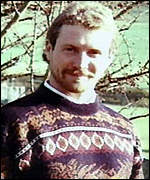 More than twelve years after the murder of MAG de-mining specialist Christopher Howes (left) and his translator Houn Hourth, six men are now in custody in Phnom Penh's Prey Sar Prison awaiting trial. Investigations are still taking place so no date for the trial has been announced and even more arrests may be made. The arrests were something I never really expected to happen, so that in itself has been a massively positive step in the right direction in resolving this murder case. The prosecution have had twelve years to put their case together - let's hope its water-tight and that the truth will be told and the perpetrators found guilty. This is one instance where the Cambodian authorities can achieve an outcome that will send a positive message to all that justice can be achieved in Cambodia. I live in hope.
More than twelve years after the murder of MAG de-mining specialist Christopher Howes (left) and his translator Houn Hourth, six men are now in custody in Phnom Penh's Prey Sar Prison awaiting trial. Investigations are still taking place so no date for the trial has been announced and even more arrests may be made. The arrests were something I never really expected to happen, so that in itself has been a massively positive step in the right direction in resolving this murder case. The prosecution have had twelve years to put their case together - let's hope its water-tight and that the truth will be told and the perpetrators found guilty. This is one instance where the Cambodian authorities can achieve an outcome that will send a positive message to all that justice can be achieved in Cambodia. I live in hope.You can read my detailed notes on Christopher Howes and the full story here.
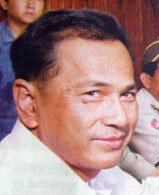 The sixth suspect, Puth Lim was arrested on Friday, in the southern town of Kampot. He has allegedly been in hiding for a number of years in the former Khmer Rouge stronghold of Anlong Veng, though the press have also claimed he was Pol Pot's graveyard keeper, which if true, doesn't ring true with the 'in hiding' claim as the gravesite has been a tourist attraction for quite some time. It's also claimed he was the driver of the car that transported the two de-miners to their death. Puth Lim is the latest to be arrested, following the high profile arrest of three other former KR cadre last November, including the man suspected of supervising the killing, Khem Nguon (pictured), and two others more recently. The names of those in custody today are Khem Nguon, Loch Mao, Chep Cheat, Sin Dorn, Horm Hai and Puth Lim. Horm Hai was arrested recently, though his arrest was not announced by the the deputy director of the Phnom Penh Municipal Court, Ke Sakhorn, until sometime later. Sakhorn also explained that the cases have been transferred from the Siem Reap court, where the original application was made, because there were believed to be former Khmer Rouge leaders in Siem Reap who would have made investigations difficult!
The sixth suspect, Puth Lim was arrested on Friday, in the southern town of Kampot. He has allegedly been in hiding for a number of years in the former Khmer Rouge stronghold of Anlong Veng, though the press have also claimed he was Pol Pot's graveyard keeper, which if true, doesn't ring true with the 'in hiding' claim as the gravesite has been a tourist attraction for quite some time. It's also claimed he was the driver of the car that transported the two de-miners to their death. Puth Lim is the latest to be arrested, following the high profile arrest of three other former KR cadre last November, including the man suspected of supervising the killing, Khem Nguon (pictured), and two others more recently. The names of those in custody today are Khem Nguon, Loch Mao, Chep Cheat, Sin Dorn, Horm Hai and Puth Lim. Horm Hai was arrested recently, though his arrest was not announced by the the deputy director of the Phnom Penh Municipal Court, Ke Sakhorn, until sometime later. Sakhorn also explained that the cases have been transferred from the Siem Reap court, where the original application was made, because there were believed to be former Khmer Rouge leaders in Siem Reap who would have made investigations difficult!For me this murder case is personal. I never met Christopher, who was killed in March 1996 after his abduction, but I was affected by his disappearance, both because he was a fellow Brit in Cambodia - I first visited Cambodia at the end of 1994 and was deeply in love with the country - and also because he came from Bristol, just twenty minutes drive from my own home. I was in contact with his parents at the time and two years later I received an invitation to attend a memorial service in his honour but regrettably I wasn't able to attend. The two de-miners died whilst trying to rid Cambodia of the scourge of landmines - something that upset the KR hierarchy and signed their death warrants - and they deserve justice, even after so long.
Sunday, May 18, 2008
Chrouy Changva Take 2
Chrouy Changva Take 1
Frustration reigns
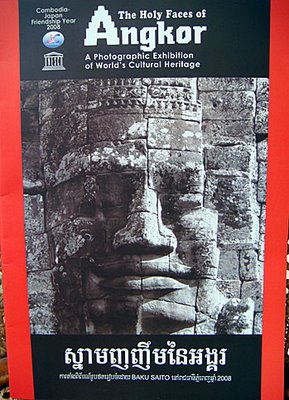 This is the brochure cover for the exhibition The Holy Faces of Angkor, which is as close as I got to see the exhibit of sixty photographs by Japanese freelance snapper Baku Saito! The exhibition kicked off early on Saturday morning with speeches by Sok An and Veng Sereyvuth, two of the government's top guns as well as Baku himself. Unfortunately I wasn't aware of the morning ceremony at the HQ of CJCC on Russian Boulevard and got there a little after 2pm, to find that the exhibition had already closed for the day and wouldn't reopen until Tuesday. Its on until 31 may, so I will see it in due course, but Saturday's frustration was just the start. It then rained for an hour but before I left I liked the look of the fancy little circular building next to CJCC and was told it was one of renowned Cambodian architect Vann Molyvann's creations. In fact it turns out to be the Institute of Foreign Languages library and is modeled after traditional woven palm-leaf hats and is set in its own small, circular moat. I headed for the Olympic Stadium intending to see a game of football from the Cambodian Premier League, only to be told all games were off this weekend, though I could try the Old Stadium. Now taken over by the Army, the pitch was being watered and looked lush, but there were no games here either. Damn. Even the Cambodia versus Palestine match next Saturday has been cancelled. Down in the dumps, I headed home only to find my internet connection was down too, the first time in the half a dozen months I've been online at home. It was just one of those afternoons I guess.
This is the brochure cover for the exhibition The Holy Faces of Angkor, which is as close as I got to see the exhibit of sixty photographs by Japanese freelance snapper Baku Saito! The exhibition kicked off early on Saturday morning with speeches by Sok An and Veng Sereyvuth, two of the government's top guns as well as Baku himself. Unfortunately I wasn't aware of the morning ceremony at the HQ of CJCC on Russian Boulevard and got there a little after 2pm, to find that the exhibition had already closed for the day and wouldn't reopen until Tuesday. Its on until 31 may, so I will see it in due course, but Saturday's frustration was just the start. It then rained for an hour but before I left I liked the look of the fancy little circular building next to CJCC and was told it was one of renowned Cambodian architect Vann Molyvann's creations. In fact it turns out to be the Institute of Foreign Languages library and is modeled after traditional woven palm-leaf hats and is set in its own small, circular moat. I headed for the Olympic Stadium intending to see a game of football from the Cambodian Premier League, only to be told all games were off this weekend, though I could try the Old Stadium. Now taken over by the Army, the pitch was being watered and looked lush, but there were no games here either. Damn. Even the Cambodia versus Palestine match next Saturday has been cancelled. Down in the dumps, I headed home only to find my internet connection was down too, the first time in the half a dozen months I've been online at home. It was just one of those afternoons I guess.Illustrator extraordinaire
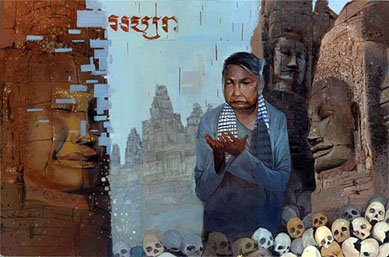 A Cambodian-born illustrator, painter and sculptor, Andrew Hem, is earning rave reviews and plaudits for his expanding body of work and already includes Adidas, Sony Pictures and The Los
A Cambodian-born illustrator, painter and sculptor, Andrew Hem, is earning rave reviews and plaudits for his expanding body of work and already includes Adidas, Sony Pictures and The Los 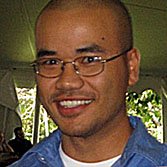 Angeles Times amongst his clients, with successful exhibitions in London, Italy and across the United States also in the bag. He left Cambodia with his parents as a toddler to make a new life in the US and now lives in Los Angeles. His formative years in graffiti art prepared him well though it was as an illustrator that he felt he'd found his true course. His artworks have a unique, edgy, slightly disturbing style that have won him many friends and supporters in the art world since his graduation just two years ago. This man is going places. Link: website
Angeles Times amongst his clients, with successful exhibitions in London, Italy and across the United States also in the bag. He left Cambodia with his parents as a toddler to make a new life in the US and now lives in Los Angeles. His formative years in graffiti art prepared him well though it was as an illustrator that he felt he'd found his true course. His artworks have a unique, edgy, slightly disturbing style that have won him many friends and supporters in the art world since his graduation just two years ago. This man is going places. Link: website
Another arrest in Howes case
For more on Christopher Howes, please visit my website here.
Saturday, May 17, 2008
Mini-treasure trove
Friday, May 16, 2008
A legacy of lions
Oudong's killing fields
Weekend viewings
Visiting friends
Thursday, May 15, 2008
A smile goes a long way
For Sum Song Zoning, a community officer with the Wildlife Conservation Society (WCS) of Cambodia, the secret to conservation is a good sense of humor. His audience: monks and farmers, housewives with screaming babies – each with a skeptical look that deepened as the morning heat rose. His subject: the Bengal Florican, an endangered bird few have ever heard of, let alone seen. His task: to convince the lean-looking villagers that, should they ever come across the bird, a hefty five-pounder, it is better to save it than to eat it. By all accounts, he succeeded wonderfully. There were cheers as he took playful jabs at a monk and teased two bemused old ladies, using humor to impart the value of the bird. Diagrams and posters were marshaled to explain that, as much as they look alike, Bengal Florican eggs are not duck eggs and should be left alone. During the quiz at the end, the 30 or so participants raised their hands with gleeful eagerness, suggesting that, whether or not they ever saw the bird, they were ready to protect it. “Ten years ago, people didn’t understand the importance of the bird,” says Zoning. “Now they understand that it’s something special for Cambodia.”
Village by village, and province by province, this simple interaction is helping to save the Bengal Florican, one of the world’s rarest birds, by directly engaging the communities that dwell in the bird’s habitat. And in so doing, this approach is presenting a unique model of community-based conservation, observers and participants say. “This is a model of conservation between communities and conservationists,” says Robert van Zalinge, a field technical adviser for the WCS. “In remote regions, protected areas are set up just based on government decisions, and that is enforced. But here, in an area of high human population, you have a much larger community interface than any other protected area in Cambodia.” For bird enthusiasts, the Bengal Florican is prized for its rarity, being native to only three countries in the world: Cambodia, India, and Nepal. Today there are believed to be roughly 1,300 left in the world, with about 800 to 900 in the flood plains of Cambodia’s Tonle Sap Lake, the largest freshwater body in Southeast Asia, according to research conducted by WCS. To scientists, the bird is unique for its elaborate mating ritual, or display: the otherwise secretive males make hopping loops in the sky, hoping to attract female attention with their striking presence – black bodies set against glaring white wings. “They’re very difficult to see. But when they display, the male sort of advertises its territory, trying to attract females,” says Lotty Packman, a doctoral student from England who is assisting the WCS to track and tag the birds. For the people in these stark grasslands, though, where scarcity is a way of life, the bird is a potential source of income or food. By the 1990s, hunting had significantly diminished its numbers. Today the bird faces an even greater threat: the grasslands of the Tonle Sap, which used to stretch for hundreds of miles, are quickly diminishing as private companies convert land into large-scale rice-farming operations. Almost 30 percent of the grasslands were lost in 30 months from 2005 to 2007, warns a recent report by the WCS. “At that rate, in five to 10 years, the grasslands could be gone and the Florican extinct,” says Mr. Van Zalinge.
To prevent that, conservationists worked with the provincial governments in the flood-plain area to devise a solution: an Integrated Farming and Biodiversity Area – a protected area that outlaws large-scale dry rice farming, which damages the Florican’s habitat, but allows farmers to continue traditional methods of deep-water rice farming. The latter’s use of grazing and burning supports the Florican by preventing the growth of scrub that destroy the grass patches favored by the birds. In 2006, a provincial government decree designated 135 square miles of the flood plain a protected area, preserving roughly half of the Bengal Florican population here. So far, the provincial governments have stopped at least two large-scale dry rice projects, according the WCS, suggesting the firm commitment of local authorities. What makes the project novel is also the level of community involvement. As many as 20 times a month, community officer Zoning and others gather several dozen people in towns throughout the Tonle Sap flood plain. Men and women, young and old: Their participation has helped the Bengal Florican return, like the rest of Cambodia, from a devastating past. It is too early to say how successful the protected areas have been in increasing the overall population of Cambodia’s Bengal Florican. For now, project administrators say, success means reaching people like Meach Komhan, a farmer in the district of Baray, part of the flood-plain area. “I had never heard of the bird before,” he says, after listening to Zoning’s presentation. “I really support the conservation, because the bird is useful for Cambodian people as a natural resource. We don’t want to lose it in the future.”
The pulse of UK reggae
The pulse of UK reggae by Bobby Tanzilo (OnMilwaukee.com)
If you saw me driving to work today, you likely heard me singing along to Steel Pulse's 1982 'True Democracy,' which I extracted from the shelf this morning for the first time in many, many years. The news that the band comes to Summerfest this year - on the The Potawatomi Bingo Casino Stage & Pavilion with Miller High Life and OnMilwaukee.com - led me back to this record that was among my favorites when I was 15 and 16. I was amazed that I could remember not only every word, every drum fill, every guitar line, but also the vocal ad libs. I guess I listened to it more than a few times. Along with the band's 1978 debut, 'Handsworth Revolution,' it is an absolute classic U.K. reggae disc (ask me and I'll bore you with the others, too) and pretty high up on the list of all reggae records (we snobs make a distinction between music from Jamaica and from everywhere else).
'True Democracy' was exciting and alive when it was released. It was a bridge between rock and reggae with chicken scratch guitars, incendiary drumming and on-the-money harmonies combined with great songwriting. It also arrived at a definitive time for me. I was teaching myself to play the bass and 'True Democracy,' along with the other great records of the moment - Black Uhuru's 'Red,' Bob Marley & The Wailers' 'Uprising' and Aswad's 'New Chapter in Dub,' among them - were the best teachers a kid could ask for. They were all fueled by bass runs that were snaky and full of finesse, but were also repeated many times, allowing me to pick out the notes (and I say "pick," but I certainly did NOT use a pick, thank you very much!). The disc also helped me join my school's Jamaican community - this was Brooklyn remember - at least as an honorary member. Standing in line in the cafeteria listening to 'True Democracy' in my Walkman (remember those?!), the Jamaican kid in line behind me somehow realized or suspected that we were listening to the same record. We were and I was in.
Then there was that improbable column of dreads sported by singer and guitarist David Hinds on the cover of the U.S. release. It seemed amazingly tall and revolutionary - like a big middle finger to the people that still fought against dreadlocks (yes, there was a time when dreads were not a hip trend and kids got kicked out of their houses for sporting them) - and we had no idea just how it would continued to taunt gravity before it fell over and Hinds started tying it up 'round itself. I've seen Steel Pulse a number of times since then and the band is always killer live. Although, I don't hesitate to say that once drummer Steve 'Grizzly' Nisbett left the band, the thumping heart of Steel Pulse was gone even if the brain and the body was still alive. But go buy 'True Democracy' and feel the fire. Then go see Steel Pulse and I guarantee you that - Grizzly or no Grizzly (certainly no Grizzly, sadly, because he's retired) - Hinds and company will put on a stellar show.
Wednesday, May 14, 2008
Colonial-style
Tuesday, May 13, 2008
Last of the face towers
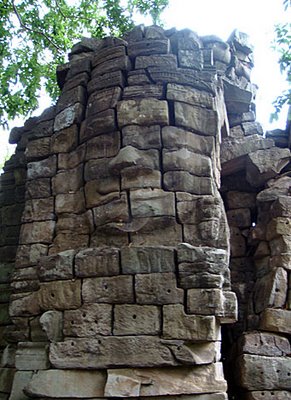 Tower 18's north face is in a perilous state
Tower 18's north face is in a perilous stateTitbits from PP
The Cambodian Premier League football season has recently kicked off and I am still scrabbling around trying to get the fixture list so I can get along to the Olympic Stadium to watch a few games. I'm currently suffering severe starvation for live football since my relocation to Cambodia. The end of the English Premiership season last weekend - which I watched on multi-screens at The Gym bar - doesn't exactly help either. I'm told the Cambodian League games are played on Saturday & Sunday and Wednesday but trying to locate a fixture list has so far proved impossible. However there is light on the horizon. The Cambodian National team has three games at home later this month as part of the Asian Football Confederation Challenge Cup, a tournament for emerging football nations. Cambodia will play Palestine on 24 May, Nepal on 26 May and Macau on 28 May, with all three games at the Olympic Stadium in Phnom Penh. The winner of this mini-group will go forward to compete in the 8-team Challenge Cup finals in India in July and August. Even I should be able to attend at least one of the games to satisfy my craving for live football.
I was very pleased to get a note from the author Milton Osborne a couple of days ago, who thanked me for my coverage of his recent book launch in Phnom Penh. He also mentioned a further delay of the arrival at Monument Books of his new book, Phnom Penh - A Cultural and Literary History. I'm still reading the book and will review it very soon.
My trip to Laos - did I mention it? - has been postponed for the time being. I was due to spend more than two weeks travelling from north to south in Laos from the end of this week, getting my first glimpse of the country and its people, but a lack of experienced staff in the office has meant I will now re-schedule my trip until June or July. A pity as I was looking forward to it, but it will happen, just later rather than sooner.
Last and certainly least, the closing date for registering political parties and their candidates for the 27 July general election here in Cambodia has passed. In all, 12 parties have registered, half of the number from the 2003 general election, where CPP won control with 73 seats out of 123. Its already dominating the headlines over here with dirty tricks much in evidence from all quarters. I expect it to get a lot worse as election day draws closer.
Whoops, I forgot to mention its the Cambodian King's birthday tomorrow - King Sihamoni will be 55 - and today is the first of a 3-day public holiday. However, I work in tourism so public holidays here mean diddly-squat. To celebrate his birthday, the face of the King will now appear on a new 20,000 riel note (worth $5.5) , printed by the National Bank.
Monday, May 12, 2008
Rahu bas-reliefs
Sunday, May 11, 2008
Making faces
Faces and Tower 15 revealed
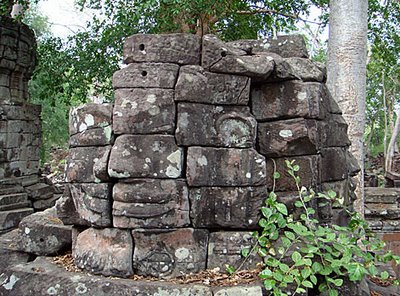 The west face of tower 15 at Banteay Chhmar and the profile of the south face (right of the photo)
The west face of tower 15 at Banteay Chhmar and the profile of the south face (right of the photo)Facing danger
Saturday, May 10, 2008
The eastern gopura at Banteay Chhmar
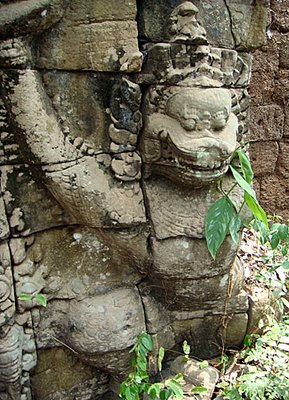 Above: One of a series of lions and garudas with arms aloft to support the celestial realm in the area of the broken eastern gopura
Above: One of a series of lions and garudas with arms aloft to support the celestial realm in the area of the broken eastern gopura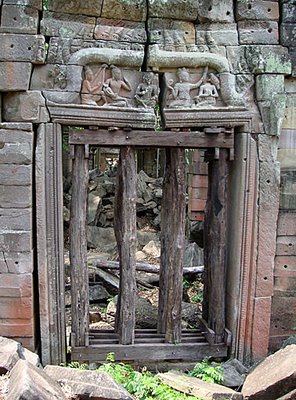 Above: A good example of the precarious nature of much of Banteay Chhmar as wooden supports keep this interesting pediment - the slaying of Shishupala with Krishna and rishis also present - in the eastern pavilion
Above: A good example of the precarious nature of much of Banteay Chhmar as wooden supports keep this interesting pediment - the slaying of Shishupala with Krishna and rishis also present - in the eastern pavilionOn the run at Chhmar
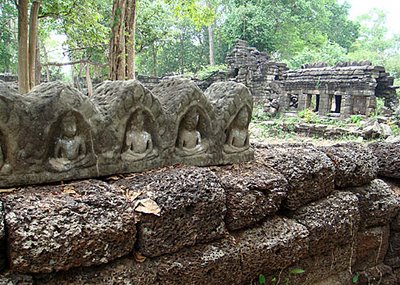 Above: These roof finials are located inside the second enclosure of Banteay Chhmar and show small Buddha figures in meditation
Above: These roof finials are located inside the second enclosure of Banteay Chhmar and show small Buddha figures in meditation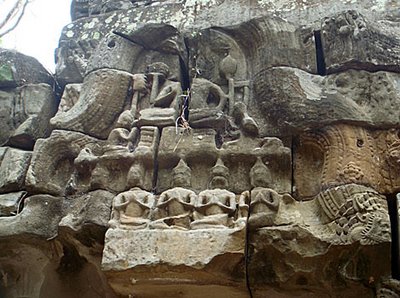 The pediment above shows a bodhisattva seated on a low plinth with two worshippers at his side, over a row of five remaining figures seated in anjali pose
The pediment above shows a bodhisattva seated on a low plinth with two worshippers at his side, over a row of five remaining figures seated in anjali poseFriday, May 9, 2008
Valmiki and Brahma
Pediments in close up
Above is a pediment on the eastern face of tower 8 that depicts the Lokeshvara with eight arms standing on a plinth supported by three lions. Worshippers surround the feet of the Lokeshvara in an attitude of anjali, with their hands clasped together in front of their chests, palms joined in prayer. The block of sandstone containing the face has been crudely removed, as has the lintel that should be sat underneath the pediment. The scene is in more detail below.
Above & below. This busy well-preserved pediment, with a multitude of figures, can be found on the western side of the corner pavilion 28. The crowned Buddha is in meditation and is seated on a plinth, with two monks at his side over a row of seven worshippers. Two apsaras are floating hear his head. The worn lintel underneath shows Buddha being held aloft over a kala.
Thursday, May 8, 2008
It's so easy by eBay
You can purchase the CD's via eBay at Hello Sailor and Fun With Dave. Roy is currently remastering his solo album, produced by Gus Dudgeon in 1978, for a second release very soon, alongwith two Cry No More CDs, Cry No More and Live at the Mulberry Tree. Find out all you ever wanted to know about Roy here.
A dream comes true
A dream comes true
The inauguration this week of a new mosque in the Cambodian village of Tramung Chrum will represent a dream come true for residents of the Muslim enclave in the overwhelmingly Buddhist country. That dream was brought to life by Alan Lightman, MIT physicist and writer who a decade or so ago, with his wife, Jeanne, made a pact to turn their energies toward humanitarian pursuits. Without a firm direction or funding, they formed the nonprofit Harpswell Foundation in 1999. Within a few years, Lightman, Jeanne and their daughter, Elyse, would attend the opening of a school built in an impoverished village 50 miles from Phnom Penh, build and manage a women's dorm and leadership center in Phnom Penh and, finally, build the new mosque in Tramung Chrum. Lightman has been entranced by science and the arts from an early age. Appointed professor of science and writing and senior lecturer in physics at MIT in 1989, he went on to head the Program in Writing and Humanistic Studies from 1991 to 1997 and helped found the Catalyst Collaborative, a collaboration between MIT and the Underground Railway Theatre of Boston in 2004. His novel, "Einstein's Dreams," published in 1993, was an international bestseller and has been translated into 30 languages.
Professor Lightman first heard of Tramung Chrum, a tiny Muslim village in Cambodia, in 2003 from the Rev. Fred Lipp. Lipp, who had been working to keep young girls in school in Cambodia with his own foundation, told Alan of a village whose only school had a roof of palm fronds. Lightman's imagination was kindled and in December of that year he and daughter Elyse accompanied Lipp to Cambodia. What they found was a village of about 500 people - mostly Muslim Chams, one of Cambodia's ethnic minorities. With neither running water nor electricity, the local economy was based on subsistence farming and menial labor. "We were overwhelmed with emotion," Lightman says softly, his eyes lighting at the memory. "These people had gone through tremendous suffering since the mid-1970s and the genocide perpetrated by the Khmer Rouge, and in spite of that they had hope and resilience. "The best expression of that hope for the future," he says, "was when we arrived, mothers holding babies came up and asked for our help to build a school. They had nothing, lived in abject poverty, but wanted a school, a future. We were so moved." Funded by donations from family and friends, the school was finished in the summer of 2005. Where a roof of palm fronds had been now stands a concrete-and-steel-girder school.
The impetus for his next project came from Veasna Chea, a native of Tramung Chrum who had made it through law school in Phnom Penh by living with three female classmates in the space on the mud floor beneath the school for four years. Male students could live in the Buddhist temples, but in the gritty capital, there were few, if any, safe places for women to stay, so few women attended college. Once again, he took on the challenge, found contractors and built the dormitory and leadership center. But that was only the beginning. Lightman reckons, "One-third of my waking hours I spend on Cambodia daily." From sleeping security guards to the students' need for medical procedures, funds for upkeep, teachers, food and all life's issues, Lightman is the go-to guy. His daily electronic communications with the dorm represent the sole exception to Lightman's personal ban on using e-mail. He is presently trying to raise a $500,000 endowment to keep the dorm and all it offers up and running in the future.
As he busied himself managing the dorm and leadership center, the villagers of Tramung Chrum, thrilled with their school, asked him to build a mosque. To Lightman, health care seemed a more compelling need, but he understood that it had to be what the entire village wanted. So he asked the men and women of the village to choose five representatives each, and he met with the two groups separately. The men wanted a mosque, the women wanted health care. A meeting was convened to give the 10 representatives the opportunity to address the whole village and then vote on which project to take forward. After a civil discussion, all the men and three women voted for the mosque. The reason? The mosque represented their spiritual health, which they considered more important than their physical health. Lightman recognized that the cultural value and tradition was different than his own and that the social fabric of the community depended on the mosque. "They are so proud," he says, "so deeply happy with this mosque." Link: harpswellfoundation
Wednesday, May 7, 2008
Fourth arrest in Howes murder case
 There's been another development in the Christopher Howes murder case today with the news that a 4th former Khmer Rouge soldier, Sin Dorn, was arrested Friday in the former Khmer Rouge stronghold of Anlong Veng in northern Cambodia and is being held in Phnom Penh pending a trial date, which has still to be fixed. The charges against Sin Dorn, 52, are premeditated murder of Howes (pictured above) and his Cambodian translator Houn Hourth as well as illegal confinement of both men and with being a member of rebel forces. The British de-miner from Bristol and his colleague were abducted and killed a few days later in March 1996. In a surprise development in November last year, three other former communist rebels, mastermind Khem Nguon, Loch Mao, and Chep Cheat, were arrested and charged over the kidnapping and murder of Howes and Hourth. Khem Nguon, who served as number 2 to the notorious one-legged KR commander Ta Mok, had defected from the KR to join the Cambodian armed forces where he was awarded the rank of brigadier-general in the defence ministry. The others became civil servants. All four men face 20 years in prison for premeditated murder and 10 years for illegal confinement if convicted. Families of the victims filed the original complaints in the Siem Reap provincial court, but long delays forced the transfer of the cases to the Phnom Penh Municipal Court and we now await the start of the trial.
There's been another development in the Christopher Howes murder case today with the news that a 4th former Khmer Rouge soldier, Sin Dorn, was arrested Friday in the former Khmer Rouge stronghold of Anlong Veng in northern Cambodia and is being held in Phnom Penh pending a trial date, which has still to be fixed. The charges against Sin Dorn, 52, are premeditated murder of Howes (pictured above) and his Cambodian translator Houn Hourth as well as illegal confinement of both men and with being a member of rebel forces. The British de-miner from Bristol and his colleague were abducted and killed a few days later in March 1996. In a surprise development in November last year, three other former communist rebels, mastermind Khem Nguon, Loch Mao, and Chep Cheat, were arrested and charged over the kidnapping and murder of Howes and Hourth. Khem Nguon, who served as number 2 to the notorious one-legged KR commander Ta Mok, had defected from the KR to join the Cambodian armed forces where he was awarded the rank of brigadier-general in the defence ministry. The others became civil servants. All four men face 20 years in prison for premeditated murder and 10 years for illegal confinement if convicted. Families of the victims filed the original complaints in the Siem Reap provincial court, but long delays forced the transfer of the cases to the Phnom Penh Municipal Court and we now await the start of the trial. For more on Christopher Howes, please visit my website here.
Welcome to Banteay Chhmar
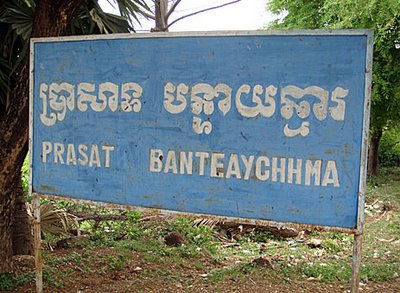 The welcome sign at Banteay Chhma(r) - causing confusion as the varied spelling of the last word can give the temple name two different meanings
The welcome sign at Banteay Chhma(r) - causing confusion as the varied spelling of the last word can give the temple name two different meanings Dogora
The postman yesterday delivered a review copy of Milton Osborne's brand new book, Phnom Penh: A Cultural and Literary History, which I will read and review soon. I attended the book launch at ACE on Friday when the author read from the only copy of his book in the city, as a shipment of the books destined for Monument Books had been held up on the dock in Sihanoukville. They are due to arrive at Monument's Norodom Boulevard shop tomorrow. As a book freak, I'm looking forward to reading his take on the various books that have mentioned the capital over the years.
Tuesday, May 6, 2008
For the Neak Ta enthusiasts...
At last, some more Neak Ta!
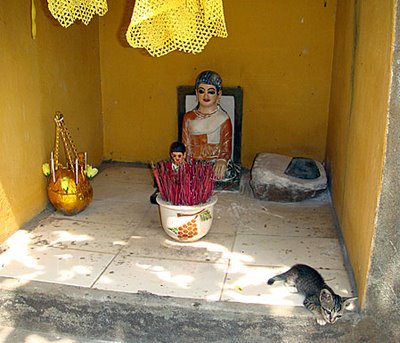 This Neak Ta shrine is also home for a tiny kitten who was enjoying a spot in the sunshine at Wat Dambouk Leak
This Neak Ta shrine is also home for a tiny kitten who was enjoying a spot in the sunshine at Wat Dambouk LeakMountain bowls
Monday, May 5, 2008
The canons of Oudong
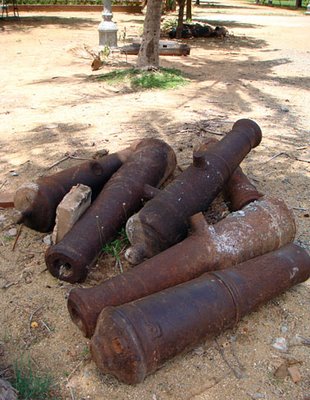 Half a dozen iron canons dating from the 17th century lie in a heap as construction work takes place in the grounds of the pagoda
Half a dozen iron canons dating from the 17th century lie in a heap as construction work takes place in the grounds of the pagodaOverdue Oudong
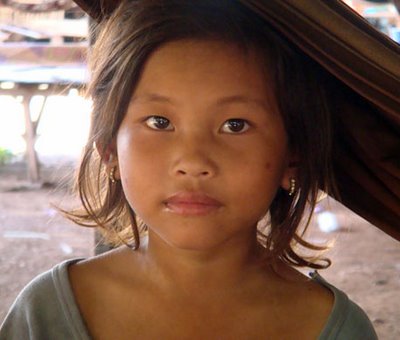 I manged to get this photo of Panmai without a spoonful of rice at her lips. Her appetite was voracious
I manged to get this photo of Panmai without a spoonful of rice at her lips. Her appetite was voraciousOn Saturday morning, I accompanied a group of my Hanuman work colleagues to a couple of hotel inspections. The Imperial Gardens Hotel and Villas, next to the Goldiana Hotel, was our first port of call. Next was the Khmeroyal, formerly Star Royal, on Sisowath Quay. Suffice to say they didn't come anywhere near the salubrious accommodation provided by Le Meridien , where I stayed last weekend in Siem Reap. However, I did spot something of note in the Khmeroyal and it was probably the worst painting I've ever seen of a group of Apsara dancers with Angkor Wat as the backdrop. Admittedly some of the art on offer in Cambodia can be a bit dicey but this picture was quite simply, crap.
Sunday, May 4, 2008
More from Ek Phnom
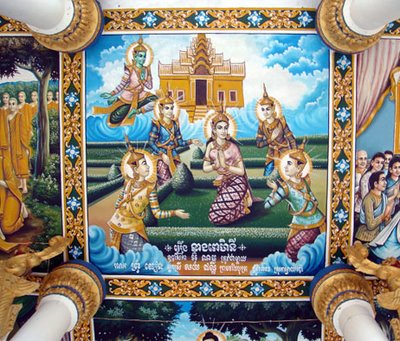 One of the colourful paintings showing scenes from the life of Buddha that decorate the ceiling of Wat Ek Phnom, the pagoda next to the ancient prasat
One of the colourful paintings showing scenes from the life of Buddha that decorate the ceiling of Wat Ek Phnom, the pagoda next to the ancient prasatSaturday, May 3, 2008
Lintels from Ek Phnom
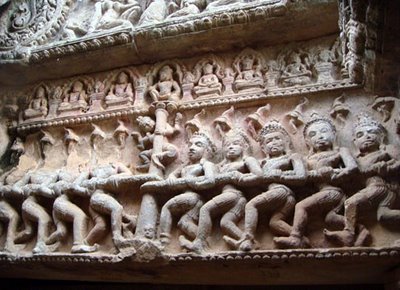 This lintel, inside the central sanctuaryat Ek Phnom, depicts the Churning of the Sea of Milk with Vishnu holding onto the pole. Some of the devas and asuras have been badly defaced
This lintel, inside the central sanctuaryat Ek Phnom, depicts the Churning of the Sea of Milk with Vishnu holding onto the pole. Some of the devas and asuras have been badly defaced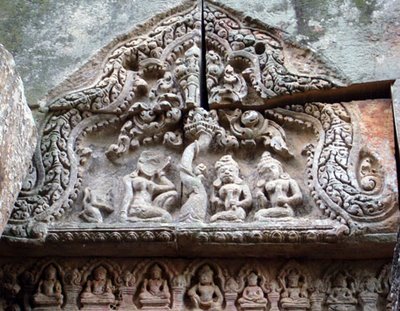 This pediment directly above the Sea of Milk lintel shows Sita (left) receiving the visit of Hanuman who is bearing Rama's ring and an offer of passage to safety
This pediment directly above the Sea of Milk lintel shows Sita (left) receiving the visit of Hanuman who is bearing Rama's ring and an offer of passage to safety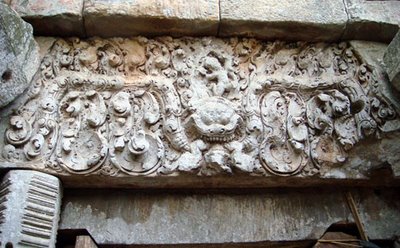 This lintel from the central tower shows Krishna with one arm raised lifting Mount Govardhana and fighting a snake, whilst standing on a kala eating a small elephant
This lintel from the central tower shows Krishna with one arm raised lifting Mount Govardhana and fighting a snake, whilst standing on a kala eating a small elephant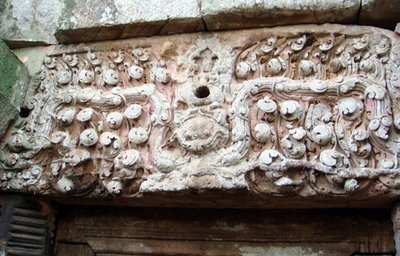 This lintel shows Shiva and his consort Uma riding the bull Nandin on top of the ever-present kala - another of the popular depictions on lintels to be found in Cambodia
This lintel shows Shiva and his consort Uma riding the bull Nandin on top of the ever-present kala - another of the popular depictions on lintels to be found in Cambodia Off the cuff
O B's adventures
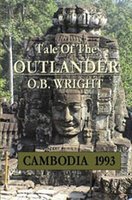 Staying on the literary theme, two books have crossed my path that will interest readers of adventure and romance stories set in the jungles of Cambodia. Author O B Wright, who lived in Thailand just a few miles from the Cambodian border for many years, has penned two books which you can track down on www.lulu.com. They are both set in the days surrounding the UNTAC invasion of Cambodia and the desperate last throws of the Khmer Rouge to regain power. Tale of the Outlander - Cambodia 1993 and Whiskey Oscar Seven Bravo...W07B/A Tale of Cambodia 1993 are a mix of the author's personal recollections and experiences amidst the intrigue and danger posed by the die-hard Khmer Rouge.
Staying on the literary theme, two books have crossed my path that will interest readers of adventure and romance stories set in the jungles of Cambodia. Author O B Wright, who lived in Thailand just a few miles from the Cambodian border for many years, has penned two books which you can track down on www.lulu.com. They are both set in the days surrounding the UNTAC invasion of Cambodia and the desperate last throws of the Khmer Rouge to regain power. Tale of the Outlander - Cambodia 1993 and Whiskey Oscar Seven Bravo...W07B/A Tale of Cambodia 1993 are a mix of the author's personal recollections and experiences amidst the intrigue and danger posed by the die-hard Khmer Rouge.
Friday, May 2, 2008
Osborne on Phnom Penh
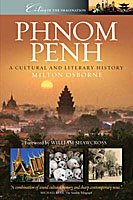 themselves were not available since they were stuck on the dock at Sihanoukville. Undaunted, Dr Osborne delivered a series of anecdotes and quotes from his new book - Phnom Penh: A Cultural and Literary History - as well as his own experiences in Cambodia, at the well-attended gathering at ACE. A veteran of no less than nine books on Southeast Asian history and politics, the Canberra professor first lived in the city in 1959 and certainly knows his stuff. He puts into context the birth of the capital in the 15th century and on through to the Sihanouk years when Phnom Penh deserved its reputation as the most attractive city in Southeast Asia, though all that was to change during the Pol Pot years. Now the city is recapturing its vibrancy and Osborne has been here often enough to be the johnny on the spot to encapsulate that into the 256 pages of his new book, published by Signal. A fitting introduction came from the Australian Ambassador, Margaret Adamson as Osborne himself was previously on the embassy staff here in Phnom Penh. The author's previous titles on Cambodia include: Politics and Power in Cambodia: The Sihanouk Years (1973); Before Kampuchea: Preludes to Tragedy (1979); Sihanouk: Prince of Light, Prince of Darkness (1994).
themselves were not available since they were stuck on the dock at Sihanoukville. Undaunted, Dr Osborne delivered a series of anecdotes and quotes from his new book - Phnom Penh: A Cultural and Literary History - as well as his own experiences in Cambodia, at the well-attended gathering at ACE. A veteran of no less than nine books on Southeast Asian history and politics, the Canberra professor first lived in the city in 1959 and certainly knows his stuff. He puts into context the birth of the capital in the 15th century and on through to the Sihanouk years when Phnom Penh deserved its reputation as the most attractive city in Southeast Asia, though all that was to change during the Pol Pot years. Now the city is recapturing its vibrancy and Osborne has been here often enough to be the johnny on the spot to encapsulate that into the 256 pages of his new book, published by Signal. A fitting introduction came from the Australian Ambassador, Margaret Adamson as Osborne himself was previously on the embassy staff here in Phnom Penh. The author's previous titles on Cambodia include: Politics and Power in Cambodia: The Sihanouk Years (1973); Before Kampuchea: Preludes to Tragedy (1979); Sihanouk: Prince of Light, Prince of Darkness (1994).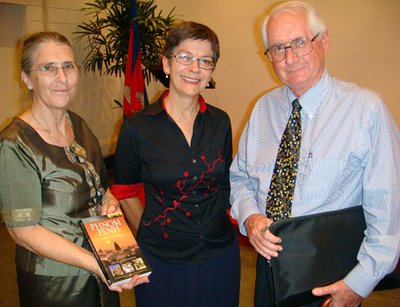 [RtoL] Milton Osborne alongside Margaret Adamson, the Australian Ambassador and Margaret Bywater from RUPP (holding the sole copy of the book at the launch)
[RtoL] Milton Osborne alongside Margaret Adamson, the Australian Ambassador and Margaret Bywater from RUPP (holding the sole copy of the book at the launch)Banteay Top full stop
Towers of Banteay Top
Thursday, May 1, 2008
Good causes
Epic Arts Cafe A friendly little café in Kampot with delicious cakes, assisting the deaf community and promoting arts for the disabled.
Friends A Phnom Penh landmark, serving tasty tapas, fusion food, delicious shakes and cool cocktails, all to help street children.
Jardins des Delice Part of the
Joe to Go Coffees before sunrise are the order of the day here in Siem Reap, all to help in the fight against child trafficking and sex tourism.
Le Lotus Blanc This professional French restaurant provides hospitality training for children from the Stung Meanchey dump area in
Le Rit's A small garden restaurant next to our head office in
Mekong Blue This quiet café near Stung Treng is part of a silk-weaving cooperative seeking to assist disadvantaged women.
Romdeng Beautifully housed in a colonial building in the capital, this is the place for traditional Khmer country cooking, including deep-fried tarantula.
Sala Bai A Siem Reap restaurant training school to help disadvantaged Cambodians, there is a choice of Asian or Western food here.
Starfish Bakery A leafy garden café in the middle of Sihanoukville, they serve great cakes and shakes, all proceeds supporting community projects.
Unique wooden beams at Banteay Top
Following in dad's footsteps
Kara Lightman: Peace Scholar aims to help women in Cambodia (Union College, New York : The Chronicle April 2008: Volume 73, Number 4)
Kara Lightman took her first trip to Cambodia in 2005 after graduating from high school. The Concord, Mass., native traveled there with her family, who had started a foundation to help the villagers of Tramung Chrum. “The first time I went, I didn’t quite grasp it. Everything was so different and frightening,” Lightman said. “The second time, I had an overwhelming sense I needed to do something. The country has been so heavily destroyed. You walk down the street and see people whose faces have been burned off.” This summer, Lightman, who was particularly taken by the plight of the women of Cambodia, will travel alone to the Southeast Asian village. Her mission: to help Cambodian girls escape lives of poverty, ignorance and domestic violence by introducing them to the importance of education.
Lightman’s efforts are being supported by the Kathryn Wasserman Davis Projects for Peace. She is one of 100 students from more than 85 American colleges and universities who will receive $10,000 to help promote world peace. An interdepartmental major in Anthropology and Political Science, Lightman is the daughter of Jean, an artist, and Alan Lightman, a professor at the Massachusetts Institute of Technology and author of the 1999 international bestseller, “Einstein’s Dreams.” In 2006, Alan Lightman created the Harpswell Foundation, a non-governmental organization (NGO), after helping a friend build schools in Tramung Chum, about 50 miles from the Cambodian capital of Phnom Penh. “We became very close with this village,” said Kara. “They have no plumbing, no running water, no electricity; they tell time by when the sun rises.”Upon learning that many women can’t go to college because there is nowhere safe for them to live (men can stay in monasteries, but Buddhist rules bar women from taking shelter there), Alan Lightman raised money and bought land, and in 2006, Harpswell built the first women’s dormitory in Cambodia, in Phnom Penh. The more than 30 young women who live there also receive room and board and leadership training. “I have been greatly inspired by this project, and now I want to do my own work to help the women of Cambodia,” Kara Lightman said. She noted that thousands of women suffer from domestic violence and marital rape, and that by 13, many girls are often sent away to work in the rice fields or as prostitutes to support their families. “I would like to encourage girls to stay in school and become educated, which will allow them to get reputable jobs and eventually give money back to their families and villages. I want to use education as a tool to given women a voice.”
One of the poorest countries in the world, Cambodia saw almost its entire educated class destroyed when the notoriously brutal government, the Khmer Rouge, took power in the 1970s. Lightman will spend about six weeks traveling around the country with three women from the Harpswell dormitory who will share their struggles and their stories. Ultimately, she wants her efforts to embody what is inscribed in both Khmer and English on the brass plaque in the Harpswell dormitory: “Our mission is to empower a new generation of Cambodian women.” Lightman will leave for Cambodia in July. After spending her fall term in Fiji, she will return to campus with a photojournalistic account of her work in Cambodia. “I’ve been there four times, and I have far more cultural shock now coming back to the States than I do when I go there,” she said. “It’s hard to go and not do anything. The people are so generous, and the thing that is so amazing is that even though they have so little, they have hope.” Lightman is the second Union student to be named a “peace scholar.” Last year, when the awards were created, Karyn Amira received funding for her efforts to curb landmines in Cambodia.
On her way up
 A Cambodian-American woman making her way in film-making in the United States is Sophia Leang. Already this year she has directed music videos for up and coming artists Kendal and Mayaeni as well as a short comedy called Peeled Grapes. Raised in Bronx, New York, Sophia abandoned her first-choice career of journalism to study filmmaking at Hunter College where she produced and directed two short films Second Chance and Morning. The round-the-clock, manic viewing of MTV had inspired Sophia to move to Los Angeles for a semester where she got the opportunity to work at Partizan Entertainments, a highly recognized music video and commercial production house. There, she worked on productions of talented directors such as Chris Robinson and Honey on big-budget music videos such as Korn, Busta Rhymes, and Stacey Orrico and commercials including Pepsi. Returning from Los Angeles, Sophia helped set up Carmona Pictures, a production company with Julissa Carmona, and they specialize in short film, trailers, music videos and most recently, feature films. She is pursuing plans to co-produce and direct her first feature, she resides in the Bronx and enjoys classic and foreign films, art and music. Keep an eye open for the work of this talented young woman. Link: sophialeang
A Cambodian-American woman making her way in film-making in the United States is Sophia Leang. Already this year she has directed music videos for up and coming artists Kendal and Mayaeni as well as a short comedy called Peeled Grapes. Raised in Bronx, New York, Sophia abandoned her first-choice career of journalism to study filmmaking at Hunter College where she produced and directed two short films Second Chance and Morning. The round-the-clock, manic viewing of MTV had inspired Sophia to move to Los Angeles for a semester where she got the opportunity to work at Partizan Entertainments, a highly recognized music video and commercial production house. There, she worked on productions of talented directors such as Chris Robinson and Honey on big-budget music videos such as Korn, Busta Rhymes, and Stacey Orrico and commercials including Pepsi. Returning from Los Angeles, Sophia helped set up Carmona Pictures, a production company with Julissa Carmona, and they specialize in short film, trailers, music videos and most recently, feature films. She is pursuing plans to co-produce and direct her first feature, she resides in the Bronx and enjoys classic and foreign films, art and music. Keep an eye open for the work of this talented young woman. Link: sophialeang
